How To Start an Ecommerce Business In India – 2024 Best Guide
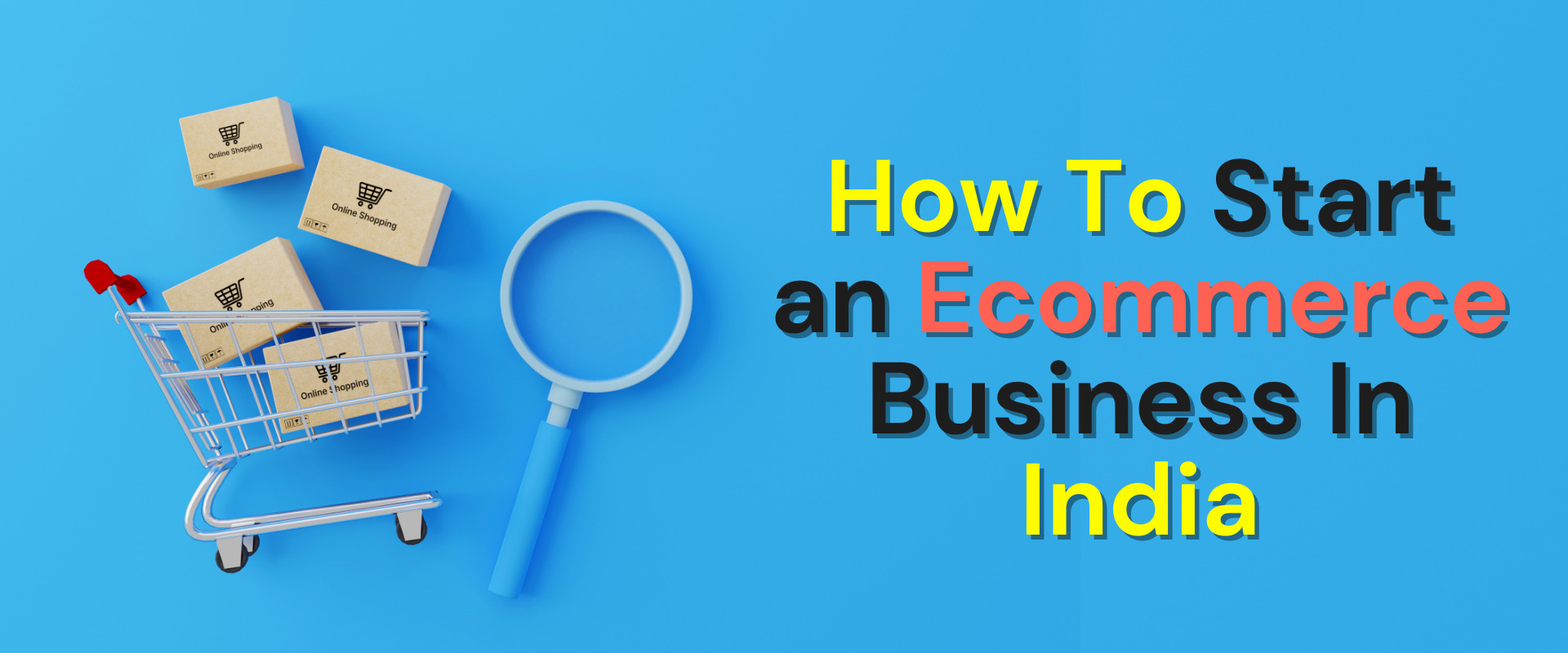
Discover the definitive guide on how to start an ecommerce business in India by 2024. Learn how to traverse the dynamic internet market and achieve business excellence by following step-by-step plans, legal requirements, market insights, and best practices.

Table of Contents
What is an ecommerce business.
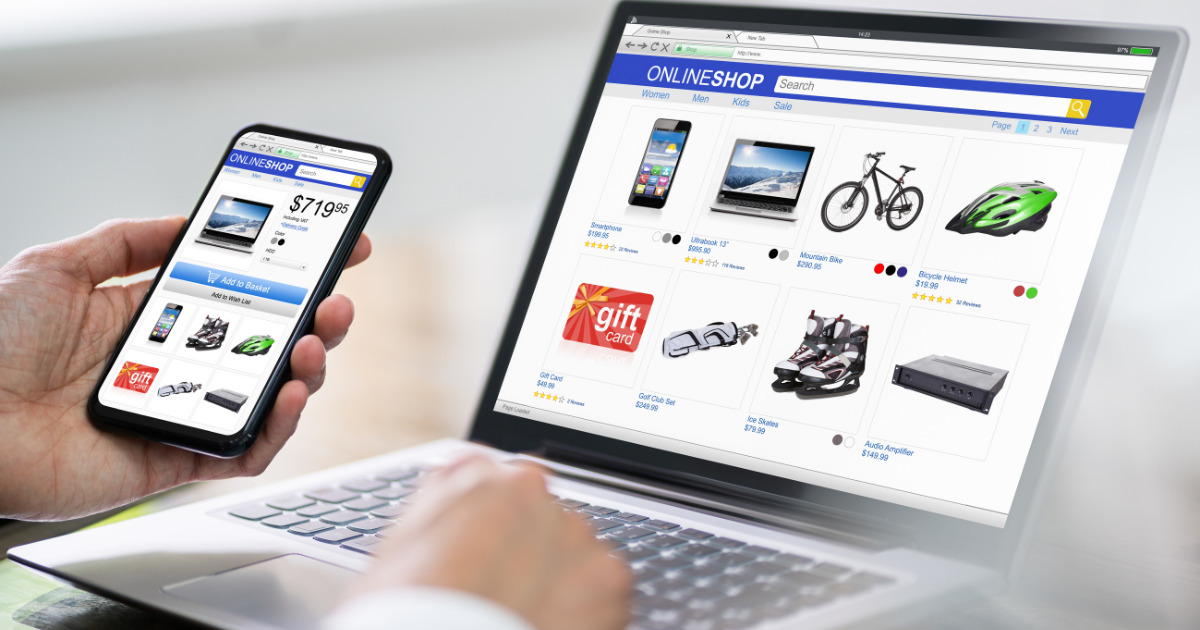
The buying and selling of goods and services over the Internet is referred to as an e-commerce business. Transactions are handled electronically in an e-commerce business, allowing customers to explore products, place orders, make payments, and receive things all through online platforms. This sort of business eliminates the need for physical storefronts and allows businesses to reach a worldwide customer base without being limited by geographical boundaries.
Ecommerce businesses can be B2B or B2C, which means they can sell to other businesses or directly to consumers. Ecommerce businesses can sell a wide range of things, including clothing, gadgets, furniture, food, and more. They can also sell services like vacation reservations, event tickets, and online courses.
How does Ecommerce Work?
Before you start learning how to start an ecommerce business in India, you need to understand how the ecommerce model works. Here is how it works:
- The buyer browses an online store and selects the items they wish to purchase.
- The buyer adds the items to their shopping cart and goes to the checkout.
- The buyer provides their contact information as well as their shipping address.
- The buyer selects a method of payment and completes the transaction.
- The products are delivered to the buyer by the seller.
Inventory management, order processing, and customer data are managed behind the scenes by integrated software systems, allowing businesses to efficiently fulfil orders and give customer service, resulting in a seamless online shopping experience.
Benefits of Starting an Ecommerce Business in India

Here are some of the main benefits of starting an ecommerce business in India:
- Expansive Market: Gain access to a fast-growing market with a huge and diversified population of 1.3B, offering enormous sales possibilities.
- Low Expense: Reduced the need for large physical infrastructure, resulting in cost reductions in terms of rent, utilities, and manpower.
- Increased Reach: Overcome geographical limitations to reach clients across the country, hence extending the customer base.
- Data-Driven Insights: Collect and analyse customer data to make more educated business decisions, personalised marketing, and better product offerings.
- Adoption of Digital Payments: Leverage India’s evolving digital payment ecosystem to improve transactional convenience for customers and enterprises alike.
- Government efforts: Take advantage of government efforts such as “Digital India,” which promotes digital literacy and online transactions.
- Scalability: E-commerce offers a scalable framework for accommodating business expansion and rising demand.
- 24/7 Accessibility: Your business is open 24 hours a day, seven days a week, allowing clients to shop whenever they choose.
- Innovative Marketing: Use digital marketing methods to target specific demographics and effectively engage customers.
- Reduced obstacles: When compared to traditional retail, there are fewer entry obstacles, allowing entrepreneurs to enter the industry with relative ease.
Types of Online Ecommerce Business in India

In India, there are many kinds of online ecommerce businesses. You need to know about all of them before you dive on how to start an ecommerce business in India. Here are a few of the most common:
Business to Business (B2B)
This form of ecommerce business sells items or services to other businesses. A B2B ecommerce business would be one that sells software to other businesses.
Business to Consumer (B2C)
This form of ecommerce firm sells items or services to consumers directly. A B2C ecommerce firm would be an online retailer that sells clothes to consumers.
Consumer to Consumer (C2C)
This sort of ecommerce allows consumers to sell products or services to one another. A C2C ecommerce business would be, for example, an online marketplace where people can sell used furniture.
Dropshipping
Dropshipping is an ecommerce business that does not hold any inventory. When a customer places an order, the merchant acquires the product from a third-party supplier and has it shipped to the client directly. The best example of this model would be print-on-demand where your products are only prepared when an order is placed. This eliminates inventory and maintenance costs and opens the door for customization. Read our detailed blog on Dropshipping vs. Ecommerce: Best one to choose in 202 4 to get a clear idea about dropshipping and ecommerce.
Affiliate marketing
This sort of ecommerce firm receives a commission by promoting the products or services of other businesses. An affiliate marketer, for example, may promote a product on their blog and get a commission if someone clicks on the link and purchases the goods. You can go through our blog on Affiliate Marketing vs. Dropshipping to learn more about this.
Subscription-based
Subscription-based ecommerce enterprises charge clients a recurring price for access to items or services. A subscription-based business might be one that delivers fresh fruits and vegetables to consumers’ homes.
How to Make an Ecommerce Business Plan?

A business plan for ecommerce is a document that covers your company’s goals, tactics, and financial estimates. If you are looking for how to start an ecommerce business in India, you must know this first. It is a must-have tool for any ecommerce business owner because it will assist you in raising finances, attracting customers, and tracking your development.
To create an ecommerce business plan, you must first:
- Define your company’s objectives. What do you hope to achieve with your company?
- Investigate the market. Who are your ideal clients? What are their wants and needs?
- Determine your competition. What are your rivals doing well? What can you improve on?
- Create a marketing strategy. How will you contact your intended audience?
- Make a spending strategy. How much capital do you require to launch your business? How are you going to make money?
Your ecommerce business plan should be a dynamic document that is routinely updated as your company develops and evolves. It is an essential instrument for assuring your company’s success.
Step by step guide on How to start an Ecommerce business in India

Here is a detailed step-by-step guide on how to start an ecommerce business in India with proper planning and execution:
Research your Business Idea
Determine a product or service that meets a market need while also aligning with your experience and passion.
Find your Niche
Narrow your attention to a certain market niche, allowing for targeted marketing and a unique value offer.
Conduct Market Research
Examine rivals, customer behaviour, and industry trends to acquire insights that can help you develop your business plan.
Choose your Product and Target Market
Choose products that will resonate with your target audience and provide a competitive advantage.
Validate your Product
To validate demand, test your product concept with a small audience or through pre-orders.
Sourcing your Product
Determine if you will manufacture your product, source locally, or use dropshipping, and establish dependable sources.
Write your Business Plan
As mentioned before, make a detailed plan including your company’s goals, target market, marketing techniques, financial projections, and operational strategy.
Decide a Name and Legalize Your Business
Choose a distinct business name, register it, and complete all legal requirements such as licences and GST registration.
Choosing an Online Selling Channel
Decide where you’ll sell your products: on your own website, through existing e-commerce platforms, or a combination of the two.
Set up your Online Store
Build and customise your e-commerce website to ensure a user-friendly layout, clear product descriptions, and easy navigation.
Find The Perfect Logo
Create a logo that reflects your brand identity and resonates with your target audience.
Select Payment Methods
Integrate secure and diversified payment gateways to cater to a wide range of consumer preferences. Consider adding options like credit cards, debit cards, net banking and UPI for the ease of the customers.
Prepare For The Launch
Thoroughly test your website, ensuring that all links and capabilities operate, and stock up on products.
Brand Your Brand
Develop a consistent brand identity, including graphics, tone, and messaging that are relevant to your target market.
Find Logistics Partner
Work with reputable logistics companies to ensure efficient order processing, shipment, and delivery.
Market your Business
Use a combination of digital marketing methods such as SEO, social media, content marketing, and paid advertising to boost your sales.
Build A Strong Customer Base
Focus on providing outstanding customer service, engaging with customers on social media, and gathering feedback to improve.
Additional Tips for Starting an Ecommerce Business in India
Here are some additional tips on how to start an ecommerce business in India and execute it perfectly:
- Customise your content for diverse Indian languages and cultures.
- For India’s mobile-driven market, make sure your website is mobile-friendly.
- Showcase reviews to gain buyer confidence and trust.
- Display endorsements and influencer collaborations on social media.
- Provide popular local payment methods to ensure smooth transactions.
- Take advantage of amazing offers during Indian festivities.
- To provide better assistance, provide multilingual support.
- Optimise for local keywords to attract clients in your area.
- Optimise site speed for different internet connections.
Successful Ecommerce Business Examples

Here are some examples of some businesses that cracked the code on how to start an ecommerce business in India and are doing pretty well in their fields:
Boat is a smartphone, headphones, speaker, and other audio equipment manufacturer based in India. Aman Gupta and Sameer Mehta launched it in 2016. Boat has become one of India’s most popular audio brands, because of its low costs and beautiful designs. In addition, the company has moved into other product categories such as smartwatches and fitness bands.
Bombay Shaving Company
Bombay Shaving Company is a shaving and grooming brand based in India that provides razors, shaving lotions, and other grooming items. Mohit Agarwal and Ankur Warikoo launched it in 2016. Bombay Shaving Company has been successful in capitalising on India’s growing demand for luxury shaving goods. The company sells a variety of items, such as safety razors, shaving brushes, and shaving creams.
Sugar Cosmetics
Sugar Cosmetics is a cosmetics business from India that sells lipsticks, eyeliners, and other makeup items. Falguni Nayar created it in 2015. Sugar Cosmetics has become one of India’s most popular makeup brands, thanks to its low costs and diverse product line. In addition, the corporation maintains a loyalty programme that rewards customers for their purchases.
Nykaa is an Indian e-commerce portal for beauty and personal care that provides a wide range of products such as makeup, skincare, haircare, and perfumes. Falguni Nayar created it in 2012. Nykaa has risen to prominence as India’s largest beauty e-commerce portal, thanks to its diverse product offering, low pricing, and user-friendly shopping experience.
Firstcry is an Indian e-commerce portal for babies and children’s products that sells a wide range of things such as apparel, toys, and feeding supplies. Supam Maheshwari and Tarun Jain launched it in 2010. Firstcry has established itself as the largest e-commerce site for babies and children’s items in India, owing to its diverse product offering, low pricing, and user-friendly shopping experience.
Top Successful Print-on-Demand Stores Powered by Blinkstore
Now that you know how to start an ecommerce business in India, let’s take a look at some of the top blinkstore powered print on demand businesses that are doing pretty good in this field:
WQ Community

Wellness Quotient (WQ) is a community of like-minded consumers who believe that prevention is better than cure and who like to be actively engaged in the quest to improve their wellness quotient by following time-tested principles of well-being.
Swasthya Warriors
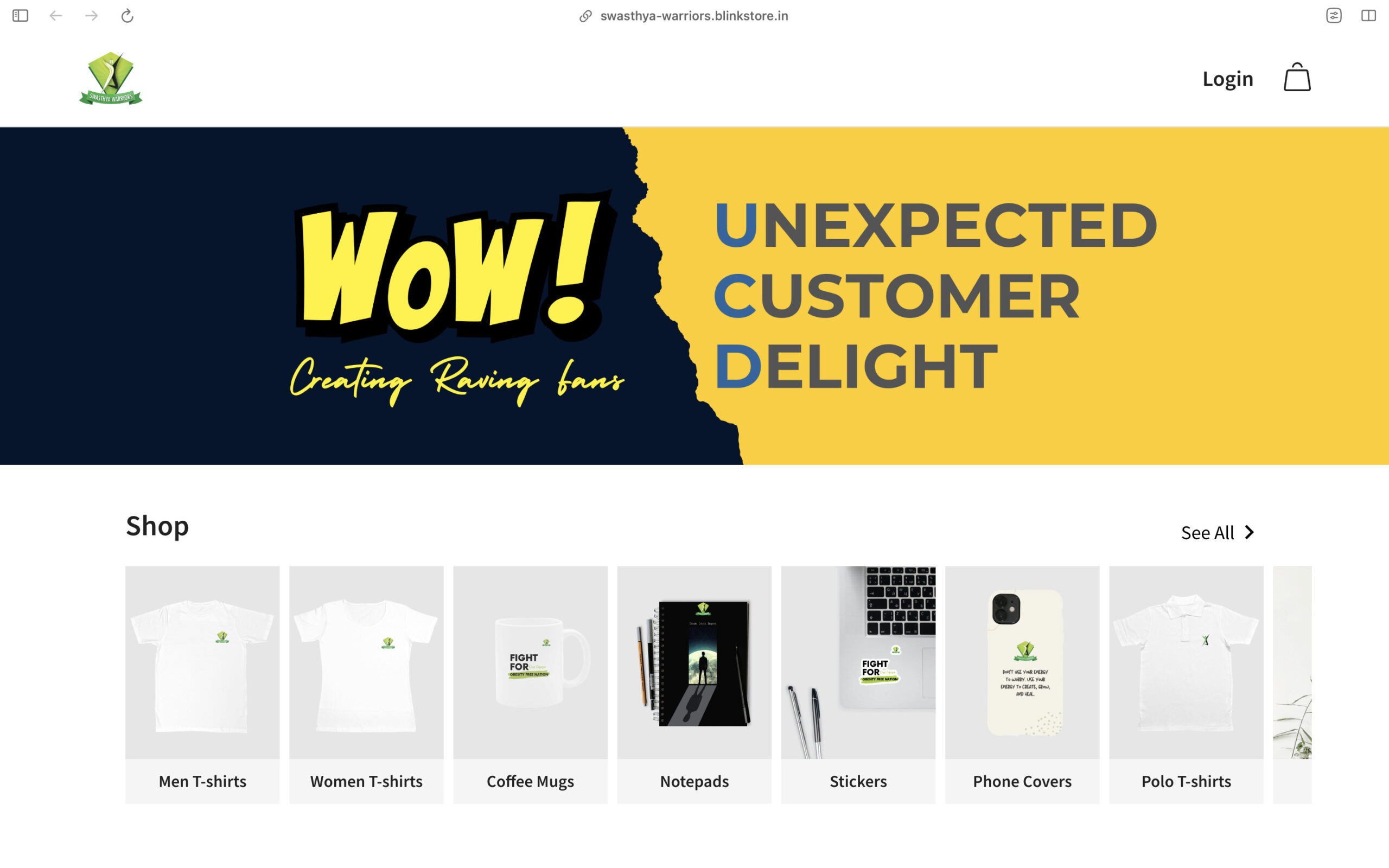
Next on the list, we have Swasthya warriors. They are also one of the most successful print on demand companies that focuses on quality and eco sustainability.
CLTR Studios
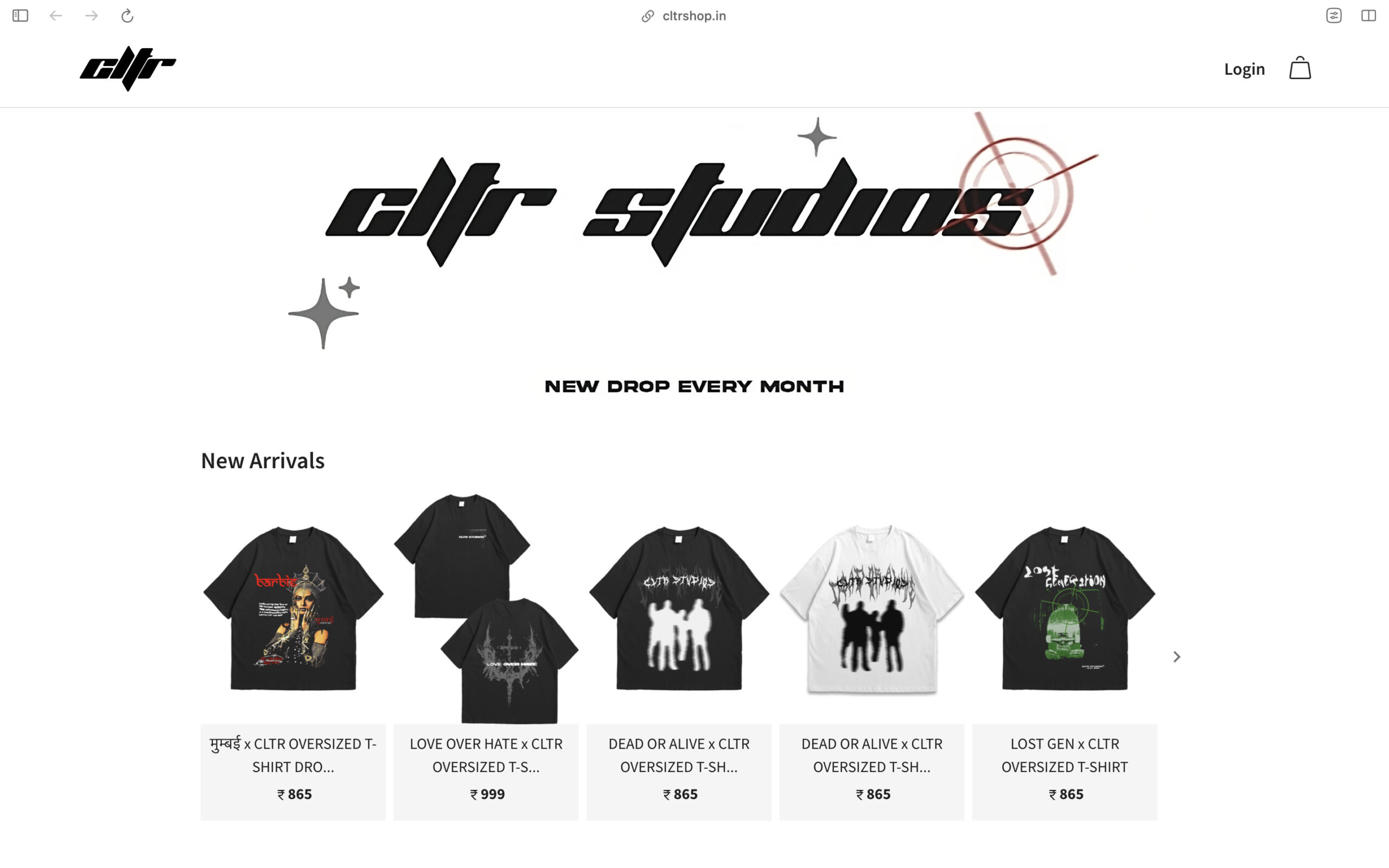
CLTR Studios has become one of the most reputed platforms when it comes to print on demand products. Their affordable and unique designs makes them stand out among the crowd.

Twocolors is another popular store powered by Blinkstore that is doing really well in the print-on-demand business. They mostly focus on premium minimalistic designs and provides one of the most efficient customer support.
Sandshandiworks
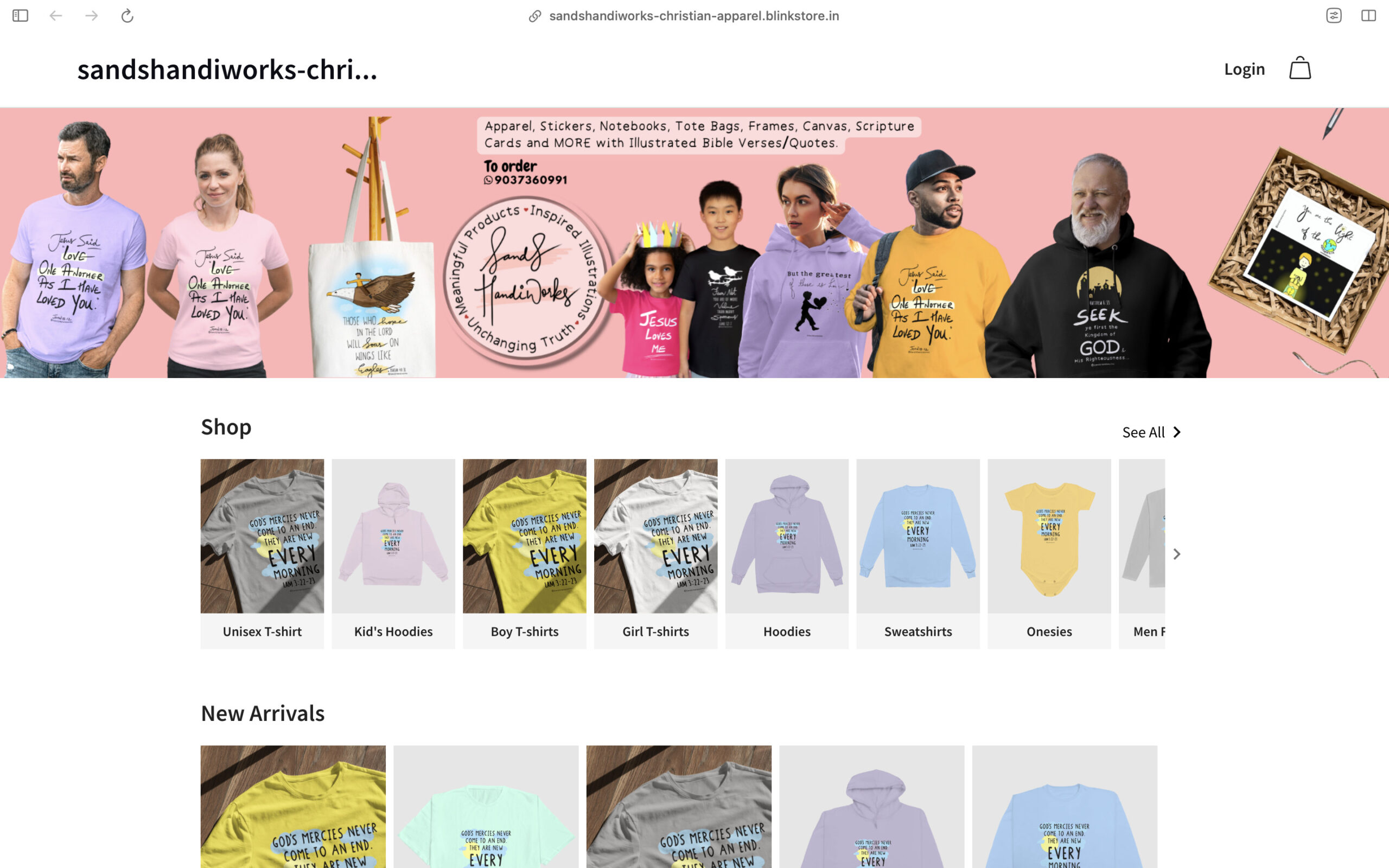
Last, but not least, we have Sandshandiworks which focuses on typographical designs that are always trendy and unique. These designs receive regular updates and always stays in fashion!
Starting an ecommerce business in India could be an excellent method to launch a new venture or expand an existing one. You can start a profitable ecommerce business with a little thought and effort. Hopefully, with our detailed guide, you will be able to figure out how to start an ecommerce business In India and become profitable.
How to find the right eCommerce platform for my business?
Compare platforms based on features, scalability, cost, and user reviews to find the one that best meets your company’s needs.
How can I start an eCommerce business in India for beginners?
Begin by studying your area, developing a business plan, selecting products, establishing an online store, and putting in place effective marketing methods.
Is e-commerce business profitable in India?
Yes, due to the developing digital market and rising customer desire for online purchasing, e-commerce can be lucrative in India.
How much investment is needed to start an eCommerce business in India?
Depending on your product range and business type, investment can range from a few thousand rupees for a small-scale operation to lakhs for larger setups.
Is e-commerce profitable?
Profitability in e-commerce is possible, but success is dependent on factors such as product selection, marketing strategy, operational efficiency, and market demand.
Is it easy to start e-commerce?
Starting an e-commerce business might be simple with good strategy, research, and execution, but it takes effort and devotion to thrive.
What is the highest salary in eCommerce?
Executive wages in e-commerce can range from several million to crores per year, depending on the function, firm size, and market conditions.
Which is the richest e-commerce?
Amazon is currently the world’s richest e-commerce corporation.
What is the most successful e-commerce?
Companies such as Amazon, Alibaba, and Walmart have had tremendous success in the e-commerce industry.
What are the top 3 biggest online shopping sites?
Amazon, Flipkart, and Myntra are the top three largest online shopping sites in India.
- Business Profiles Menu arrow Industry IT & Services Food & Hospitality Education Nonprofit Other Industries Organization Type Enterprise SMB
- Key Features Menu arrow Features and tools GST Invoices Bulk Discounts Bulk Purchasing Account Security Compliance Tools Shipping & Delivery Business Analytics tools Business Pan Payment Methods Amazon Business App Three-way Matching Amazon Business Affiliate
- Shop by Category Menu arrow Category Selection Electronic Items Office Supplies Cleaning Products Hardware & MRO Supplies Pantry Products Medical Supplies Store Security Systems Mobile Accessories Packaging supplies Gym equipments Laptop accessories Wholesale beauty products Special Stores Corporate Gifting Store COVID-19 Supplies Store Distance Learning Store Hospitality Store AWS Store Event Stores Business Value Days EMI fest Stock-up Sale Great Indian Festival
Buying guides
- search Search
There was an error fetching results
- Check your spelling
- Broaden your search by using fewer or more general words
- Free shipping
- Customer success stories

Buy products with the GST invoice and save up to 28% more on all your B2B purchases. Filter the products according to GST Invoice and save on Bulk Purchases.

Bulk purchase for all your B2B needs online with Amazon Business. Order in Bulk, Get Wholesale Benefits and much more.

Get up to 20% cashback on business purchases
Special discounts only for Amazon Business customers on business orders. Don’t miss out!

How to Start an Ecommerce Business in India: Beginner's Guide
It's no secret that the world of business is rapidly changing. Brick-and-mortar stores are being replaced by online stores, and you can now set up shop with nothing more than a website and some digital marketing savvy.
After all, many e commerce startups have already found great success in India.
Creating an eCommerce business is easy, but there are a few things you need to consider before thinking about how to start an ecommerce business. Let's take a look at how to start an ecommerce business.
If you want to get started with e commerce business, then register with Amazon Business .
What is an Ecommerce Business?
An ecommerce business is a company that conducts its business online. This means instead of selling products or services in brick-and-mortar stores, ecommerce businesses sell their wares through websites and online platforms.
Ecommerce businesses can be either B2B or B2C, e commerce business meaning they can sell to other businesses or directly to consumers. You need to familiarize yourself with these terms before thinking about how to start an ecommerce business or e commerce startups.
Some of the most common ecommerce businesses include online retailers, web-based service providers, and digital content providers.
How does Ecommerce Work?
Ever wonder how those big online stores keep track of all your purchases? Do you ever think about how ecommerce actually works? Well, to run a successful online business, it's important to understand the basics of ecommerce before pondering how to start an ecommerce business.
Essentially, ecommerce is the buying and selling of goods and services over the internet. When you purchase something from an online store, the transaction is processed through an ecommerce platform. This platform handles everything from payments to order fulfillment.
To explain further, there are three main components to ecommerce: a website or online store, payment processor, and shipping provider. The website is where customers can browse and purchase products or services.
The payment processor handles the transaction between the customer and the seller. And the shipping provider delivers the product or service to the customer's door.
Benefits of Starting an Ecommerce Business
Ecommerce is a big business these days. Interestingly, that must have been something that has triggered you into thinking about how to start an eCommerce business. More people are shopping online for everything from groceries to clothes to furniture. And there are plenty of good reasons to start an ecommerce business. Here are some e commerce benefits to consider:
- It's a great way to reach a wide audience. With an ecommerce website, you can sell to anyone in the world, like many ecommerce startups in India.
- Unlike an offline store, you're not limited by location.
- Setting up an ecommerce business is relatively easy and inexpensive. You don't need to lease a storefront or hire a staff.
Types of Online Ecommerce Business

Let's look into some of the common types of ecommerce businesses.
Business to Business
In business, it's all about who you know. And in the world of ecommerce, it's all about connecting businesses with other businesses. That's what business-to-business (B2B) ecommerce is all about. Whether it's connecting buyers and sellers of raw materials or finished goods, B2B ecommerce is a vital part of the global economy.
In fact, some estimates suggest that B2B ecommerce may even be bigger than business-to-consumer (B2C) ecommerce. Of course, the two are not mutually exclusive; many businesses do B2B and B2C ecommerce.
Business to Consumer
In a B2C transaction, a business sells products or services directly to consumers. This type of ecommerce is often used by businesses selling physical goods, such as clothing, electronics, or home goods.
However, businesses that provide services can also use a B2C model, such as a company that sells tickets to events or makes reservations for travel. While B2C transactions are typically less complex than other types of ecommerce, they can still be very successful.
Consumer to Consumer
Consumer-to-consumer, or C2C, is a common type of ecommerce business. In a C2C business, customers sell products or services to other customers. This type of business is often conducted through online marketplaces.
The e commerce benefits of C2C businesses include reaching a large number of potential customers and conducting transactions without the need for a physical store.
Consumer to Business
In a C2B model, the consumer provides a product or service to an organization. This can take the form of crowdsourcing ideas, giving feedback on products and services, or even creating content for a company's website or blog.
While it may not be the most traditional model, there is no doubt that C2B can be a powerful way for businesses to generate value from their customer base.
Consumer to Administration
C2A e-commerce has been a game-changer for how the public interacts with their local government. In the past, if someone needed information about their city or state services, they would have to go to the local office and hope someone there could help them.
With C2A e-commerce, people can simply go online and submit a request for the information they need. Not only is this more convenient for the consumer, but it also helps improve government efficiency.
Business-to-Administration
Business-to-Administration, or B2A, transactions are defined as all transactions between companies and public administrations. In other words, it's the process of businesses dealing with the government.
This can include anything from filing taxes to getting a construction permit. B2A transactions are notoriously complex and time-consuming, often requiring mountains of paperwork and mountains of patience.
These e commerce types are something you need to be mindful of before getting started on how to set up an ecommerce business.
Tips for Starting an Ecommerce Business
Here are a few tips on how to start an ecommerce business successfully:
How to start a successful ecommerce business?

So, you are looking at how to start a successful ecommerce business. That's great news! The ecommerce industry is booming with increasing ecommerce startups in India, and there's never been a better time to get started. But before you dive in headfirst, there are a few things you should keep in mind.
Let's get into the details below on how to start an e commerce business in India successfully.
Research your Business Idea
If you're thinking about how to start an e commerce business in India, the first step is to do your research. This may seem like a no-brainer, but you'd be surprised how many people skip this essential step and end up making avoidable mistakes.
There's a lot to consider when starting an online business, from choosing the right platform to building a customer base. By doing your research upfront, you'll save yourself a lot of time and headaches down the road.
Plus, you'll be in a much better position to succeed. So before you take the plunge, make sure you know how to start an ecommerce business the right way by doing your research.
Find your Niche
As anyone who has ever started an ecommerce business knows, finding your niche is essential. It helps you to focus your marketing efforts and allows you to target your ideal customer base.
Of course, finding your niche is easier said than done. With so many options out there, how do you know which one is right for you?
Here are a few tips to help you find your niche to help you get started around how to start an eCommerce business:
- Think about what you're passionate about. What are you knowledgeable about? What do you enjoy doing?
- Identify your target market. Who do you want to sell to? What needs does your target market have that you can fill?
- Do research. Once you've narrowed down your options, take some time to research each of them. This will help to understand better the market and what it takes to be successful in that niche.
- Make a decision. You'll need to decide and commit to a niche at some point. Trust your gut and go with the one that feels right for you.
Choose your Product and Target Market
You can't just "wing it" when it comes to starting an ecommerce business. Unlike a brick-and-mortar store, which can sell anything from clothes to groceries, an ecommerce business needs to have a focus. This is something you need to sort around how to start an ecommerce business.
You need to choose a product or niche and then zero in on the right target market. Only then can you create a website and marketing plan that will actually attract customers. So before you start building your ecommerce empire, take some time to figure out what you're selling and who you're selling it to.
Otherwise, you might just end up with a big ol' mess on your hands. And your strategies around how to start an ecommerce business will only fail.
Validate your Product
Before you can sell your product online, you need to be sure it's actually a good product. That's where validation comes in. Validation is the process of testing your product to see if it's actually worth selling.
There are a few different ways to validate a product, but the most important thing is to get feedback from real customers. Once you've validated your product and made sure people want to buy, you can start setting up your e-commerce business.
Sourcing your Product
Before you can start selling your wares online, you need to source your product. This may seem arduous, but with a little know-how, you can find the perfect supplier for your e-commerce business.
The first step is to identify your target market. Once you know who your customers are, you can start to research potential suppliers. Look for suppliers who offer quality products at competitive prices. You should also consider factors like lead time and minimum order quantity.
Read our blog on strategic sourcing for more detailed sourcing tips and strategies.
Once you've found a few promising suppliers, it's time to start negotiations. Be sure to get everything in writing before you make any commitments. By taking the time to source your product carefully, you can set your e-commerce business up for success.
Check out more tips on inventory management here .
Write your Business Plan
A business plan is essential for any new business, but it's especially important for ecommerce businesses. This should be on your high-priority list as you think about starting an e-commerce business.
It will help you get funding and attract investors and force you to think carefully about your business model and how you plan to make money. So don't skimp on the business planning process - it could mean the difference between success and failure.
Decide a Name and Legalize your Business
One of the first things you need to do when thinking about how to start an ecommerce business is to decide on a name. This may seem trivial, but choosing a name that reflects the products and services you offer is important. Once you've chosen a name, the next step is to register it with the government.
This will ensure that no one else can use your name for their own business. Once your name is registered, you can begin building your ecommerce website. Remember, starting an ecommerce business is a big commitment, but with careful planning and execution, it can be a very successful endeavor.
Choosing an Online Selling Channel

If you're thinking about how to start an ecommerce business, one of the first decisions you'll need to make is how to sell your products.
These days, many different online selling channels are available, and each has its own advantages and disadvantages. So, how do you choose the right one for your business?
Here are a few things to consider when plunging into how to start an ecommerce business:
- How much control do you want over the selling process? If you want complete control over every sale aspect, then selling through your website is probably the best option. However, a marketplace like Amazon or Amazon Business might be a better choice if you're willing to give up a bit of control in exchange for convenience.
- What kind of products are you selling? If you're selling physical goods, then using an online marketplace is probably your best bet. However, if you're selling digital products (such as e-books or software), setting up your own website is probably a better option.
- How much time and effort are you willing to put into marketing and promoting your products? If you're not planning on doing much marketing, then using an online marketplace can be a good way to get your products in front of a large audience with minimal effort.
However, if you're willing to put in the time and effort to market your products, then selling through your website is probably the best option.
Ultimately, there's no one "right" way to sell online. The best channel for selling your products will depend on your specific business goals and needs.
So, take some time to evaluate your options and choose the channel that makes the most sense for your business. Register with Amazon Business today and explore possibilities for your business.
Set up your Online Store
One of the most important things to do is set up an intuitive online store for anyone looking at how to start an ecommerce business. A well-designed store will make it easy for customers to find what they're looking for and give them confidence that they're making a purchase from a reputable company.
There are a few key things to keep in mind when setting up an online store, such as making sure the navigation is clear and straightforward, the checkout process is smooth and secure, and the overall design is appealing and professional. By creating a well-designed store, you'll be giving your ecommerce business the best chance for success.
Market your Business
There's no doubt that marketing is important for any business, but it's especially crucial for ecommerce businesses. After all, how can you sell products online if no one knows your website exists? Fortunately, there are several ways to get the word out about your ecommerce business.
One of the most effective is search engine optimization (SEO). Optimizing your website for search engines makes it more likely that potential customers will find you when searching for products or services like yours. Social media is another great way to market your ecommerce business.
Platforms like Facebook and Twitter allow you to connect with potential customers and promote your website or products. And of course, you can also use traditional marketing methods like advertising and PR to reach new customers. Regardless of your approach, marketing is essential for any ecommerce business that wants to be successful.
So be sure to narrow some marketing strategies while you think about how to start an ecommerce business.
How to Make an Ecommerce Business Plan?
Have you always dreamed of owning your own online store? Do you have a great product that you know customers will love but are unsure how to get started? If so, then you need to create an ecommerce business plan. This document will outline your goals, strategies, and how you plan on making your business a success.
- Start by writing down your goals
What do you want to achieve with your online store? Do you want to generate a full-time income, or are you just looking to supplement your current income? Once you have a clear idea of your goals, you can start developing your strategies.
- Figure out how you're going to reach your target market
Who are your ideal customers? Where do they hang out online? Once you know who you're trying to reach, you can start creating content and marketing campaigns that resonate with them.
- Make a financial plan
How much money do you need to get started? How much do you expect to spend on advertising and marketing? What are your estimated monthly costs? Answering these questions will give you a clear idea of how much money you need to raise and how long it will take before you start seeing a return on your investment. After all, money should be your initial thought while taking how to start an ecommerce business seriously.
Crafting a well-thought-out ecommerce business plan is the first step toward making your dream of owning an online store a reality. By sitting down and putting all your thoughts into a document, you'll be setting yourself up for success from day one.
So what are you waiting for? Get started on your ecommerce business plan today while you think about how to start an ecommerce business!
Ecommerce Business Examples
if you're looking for ecommerce business examples to get inspired by on how to start an ecommerce business, here are a few of our favorites:

Hope our list has given you some inspiration for how to start an ecommerce business.
Sell your Products on Amazon Business
Looking to take your business to the next level? Why not sell your products on Amazon Business? With millions of active users, Amazon is one of the world's most popular online marketplace platforms.
And with Amazon Business, you can reach even more potential customers. Whether you're selling physical or digital products, Amazon Business makes it easy to get started. Plus, with features like fast shipping and streamlined checkout, you can provide a seamless customer experience that will keep them coming back for more.
So what are you waiting for? Start selling on Amazon Business today ! And bring your dreams of how to start an ecommerce business to reality.
Conclusion
So there you have it, a complete guide on how to start an ecommerce business in India, starting from where the e commerce business meaning is derived from. We hope you found this article helpful and motivated you to plunge into the exciting world of online retail.
Our team is happy to assist if you're ready to get started but need some help registering your business with Amazon. Just head over to our website and register for free today.
And finally, don't forget that success takes hard work and perseverance, so stay focused and never give up!
Explore our Buying Guides
- Best Laptops for students in 2021
- Best Printers for Home & Office use
- Best Projectors for Home & Office use
- Best Home Theater system to consider
- Best Bluetooth speaker with mic 2021
- Best Earphones with mic
- Best Vacuum Cleaners in India
- Best Water Purifiers for Home & Office
Related Articles
- Purchase Order Process
- Procurement Solution
- Business Expansion
- Strategic Sourcing
- Work From Home Setup
- Start an Online Business in India
- Inventory Management
How to register an Ecommerce business?
If you are thinking about how to start a small business, here are some ideas that you can start easily include:
- Freelancing- content development, designing, video editing, etc.
- Online tutoring or course
- Consulting services
- Marketing Agency
- Video editing, production, or shooting
- SEO Consulting
- Delivery services
With these things in mind, you need not worry more about how to open a small business
Can I start an Ecommerce Business without any technology experience?
Honestly, answering this question is very subjective. If you have an answer to all the aspects of how to start a small business, then you may start setting up a small business. If you are financially secure, have a solid business plan, have a thorough understanding of your target audience, work out the marketing strategy, and feel internally stable and ready, it's the best time for you to start your business.
So next time you think about how can I start a small business, make sure that you have sorted the things above.
How long does it take for an ecommerce business to "take off"?
Well, you might be thinking hard about how can I start a small business. There is good news.
The Government of India has many schemes to support your dreams of how to start a small business at home and help you start it. Some of the schemes are mentioned below:
- Mudra Scheme
- MSME Business loan
- The Credit Guarantee Scheme (CGS)
- Stand Up India
- National Small Industries Corporation Subsidy
These schemes can help you revitalize your dreams of how to open a small business.
How do I set up logistics for an ecommerce business?
A business degree is not mandatory to start a small business. However, it may help you answer how to start a small business online or at home. However, you need a good business idea, a concrete business plan, and the right people to advise or mentor you to get you started on how to start a small business at home.
Product Updates

How to Make a Business Plan for an E-Store
An e-store business plan is a blueprint for how one will run their business, how they will fund it, who the target audience will be, and how they succeed. It’s crucial to know how to write a business strategy. It necessitates extensive study and an awareness of your target audience, financing, and other factors. Additional concerns have to be considered because e-stores operate in a virtualized world.
Seeking out investors or associates to obtain a business loan for an e-store is another phase of developing a business plan. You must present your e-commerce business in a simple style to comprehend and inspire trust for a business loan to be approved. Investors will not hop on board with a company that lacks direction or seems disorganized.
The strongest business contains growth plans, expected timetables, and financial objectives. They detect probable obstructions and design contingency plans, just like real-world route planners. They go into great depth about things like financial flow, costs, marketing materials, and distribution routes. In a nutshell, a business plan serves as the structure for any company. Here are some straightforward guidelines for creating an E-Store business plan.
Also Read: Business Plan For Mobile Store
Create an Executive Summary of Who You Are
The executive summary aims to summarise everything it follows and present a high-level description of a company to time-pressed reviewers (e.g., potential backers, business loan providers). Because this is a summary, emphasize the most important aspects one discovered when drafting your plan. An executive summary should not be more than one page and should include the following information:
- A business concept: What is the nature of the business?
- Business objectives and vision: What is the goal of the company?
- A description and distinctiveness of the product: What does the business sell, and what makes it unique?
- The target market: To whom do you sell?
- Marketing strategy: How do the business intend to interact with the customer?
- Financial situation at the moment: How much money do they now make?
- The financial situation expected in the future: What kind of income will the business think they will generate?
- The request: How much business loan for the e-site would they ask for?
- The group: Who is associated with the company?
Alson Read: 5 Costly Mistakes To Avoid While Launching Your Online Store
Acquire Financial Resources
Most entrepreneurs begin with a small amount of money and gradually increase their capital. It’s fantastic if you can acquire equipment and inventory with your money. If you are unable to do so, you have four basic options:
- A business loan for an e-store
- A partner with financial resources
- An angel investor
- A crowdfunding attempt on Kickstarter (or a similar platform)
Entrepreneurs need a business plan whether they are seeking financing or company partners. A solid plan demonstrates to shareholders that you are secure in what you’re producing, that they know the market, and that providing them with a business loan is a wise decision.
A financial plan’s degree of detail may vary depending on your target and objectives. Still, it usually includes three primary financial views: an income statement, a balance sheet, and a cash-flow statement. These financial statements help file business loans for e-site and other banking procedures.
Also Read: Why You Need To Add Multiple Payment Methods To Your Online Store
Perform a Market Analysis
Customers are crucial to any brand or business, and the ability to attract high-quality customers who stay for something more is crucial. Owners need to figure out who the main customer for the organization is. Businesses are often doomed if they don’t understand their audience or even their operating sector.
The importance of market research is crucial, and there is a significant difference between traditional companies and e-commerce in this regard. The world is the customer when it comes to e-commerce, but you’ll need to whittle it down to a certain category to promote to them.
After identifying which customer is suitable for the business, the next step is to look at their buying habits, income and consumption habits, and the types of activities they like, primarily online. To prosper, companies must resolve issues before they devastate the company.
Create a Marketing Plan
Your business concept is brilliant, and you’re operating in a burgeoning market. You must now increase traffic to your E-Site and persuade people to purchase your stuff. In a nutshell, you’ll need a solid marketing strategy. Using internet marketing tactics and social networking sites to increase sales and get real-time feedback on the quality of your shop and customer service can help you enhance your sales.
To begin, figure out how much money you want to spend on your marketing effort. Unless you have infinite finances, you’ll need to discover a cost-effective approach to get the product across the potential clients. Because each of them has benefits and drawbacks, utilize a combination of them.
For instance, SEO is a low-cost way to launch digital marketing, but it takes time. On the other hand, if you intend to spend a lot of money on Instagram advertisements, it’s a good idea to consider whether Instagram is a popular platform among your target demographic. You’ll have to engage an agent to perform it for you if you don’t have the necessary knowledge.
Also Read: 5 Clever Ways To Boost The Sales Of Your Ecommerce Store
Be Clear and Thorough with the Legalities
Several organizations govern e-commerce sites. The Federal Trade Commission (FTC), which regulates e-commerce, business emailing, internet ads, and data protection, is in charge of e-commerce. Your company strategy must explain how you will adhere to the policies’ standards and requirements.
Consider how you’ll protect consumers’ details from identity fraud and misuse. Investigate your state’s sales tax legislation to see what your state expects of internet businesses. The Digital Millennium Copyright Act — DMCA — safeguards artwork and technological products in terms of digital and copyrights. You must guarantee that your company complies with all applicable legislation.
With a great e-site, good business loan, and a well-thought-out company strategy, you’ll be well on your way to success. Understand relevant guidelines and follow them in all aspects of your business to increase your prospects of survival. A well-written business plan that gets to the point can demonstrate to investors that they know what the company is doing and have a solid strategy for success.
Related Post
Common difference between good gst and bad gst, every business must know this 45 day msme payment rule, what is emergency finance-linked guarantee scheme (eclgs) scheme, leave a reply cancel reply.
Your email address will not be published. Required fields are marked *
Save my name, email, and website in this browser for the next time I comment.
9 Most Common Challenges In Business Valuation

How to start eCommerce business in India: A start-to-finish manual
- by Hibathu Naseer
- February 10, 2022
- 8 minute read

You might agree to this that accessing the tools for launching an eCommerce business is easier than ever. Whether you’re transitioning from a physical store to online or starting a small home-based business, this blog provides essential guidance. Discover how to start eCommerce business in India with just 9 simple steps.
- 1 Why start an eCommerce business?
- 2 Is eCommerce profitable?
- 3 How much does it cost to start an eCommerce business in India?
- 4 Step 1: Determine niche & products
- 5 Step 2: Conduct market research
- 6 Step 3: Create a business plan
- 7 Step 4: Sourcing products
- 8 Step 5: Find business name and logo
- 9 Step 6: Create an eCommerce website
- 10 Step 7: What license is required for eCommerce?
- 11 Step 8: Prepare for launch
- 12 Step 9: Get your first customer
- 13 How do you calculate eCommerce profit?
- 14 From setup to sales: Create your online store with Instamojo
Why start an eCommerce business?
Why consider launching an online business in India? The reasons are numerous, spanning from increased profits to enhanced customer engagement.
View this post on Instagram A post shared by Instamojo (@instamojo_india)
However, let’s focus on the top three compelling reasons to initiate an eCommerce business in 2024.
1. Wider exposure for your business
You have the scope of getting anyone as your customer, regardless of their geographic location, as long as they have an internet connection.
The pandemic accelerated the growth of eCommerce industry — more shoppers are coming online.
A survey by Engine found that people are spending on average 10-30% more online as a result of the pandemic.
2. 24/7 shop
You can make money while you sleep, literally. By automating business processes, you will have minimal work to do. You can focus on marketing and scaling your business.
3. You can start with little to no money
If the fear of high costs is holding you back from starting your eCommerce business, it’s actually more affordable than you think, despite its perceived complexity.
You can even get a free online store with Instamojo.
Let’s explore the essentials for launching and expanding your eCommerce business in India.
Is eCommerce profitable?
So, is eCommerce a moneymaker? Well, it really depends on how you play your cards. Some online businesses hit the jackpot, making good profit margins by being smart with their plans, knowing their customers, and staying on top of the game.
But, it’s not all smooth sailing – you’ve got to deal with competition and changes in what people want.
So, if you’re up for the challenge and know your stuff, eCommerce can totally be a money-spinner.
How much does it cost to start an eCommerce business in India?
Acquiring a range of products for your inventory is essential, and the associated costs will fluctuate depending on the type of products you choose.
It is advisable to allocate a minimum budget of INR 20,000 initially. Considering the diverse expenses involved, a rough estimate suggests that around INR 85,000 to INR 1 lakh is required to initiate your own eCommerce business in India.
Guess what? You can build your online store FREE with Instamojo. Whereas, you can opt for the premium pricing for more features and theme options.
Check our premium pricing
How to start an eCommerce business in India?
Curious about launching a prosperous online business from the ground up? We’ll lead you through the steps you can initiate today, mirroring the success of many others.
For a quick overview, take a look at the following infographic. Subsequently, we’ll delve into each step in thorough detail.
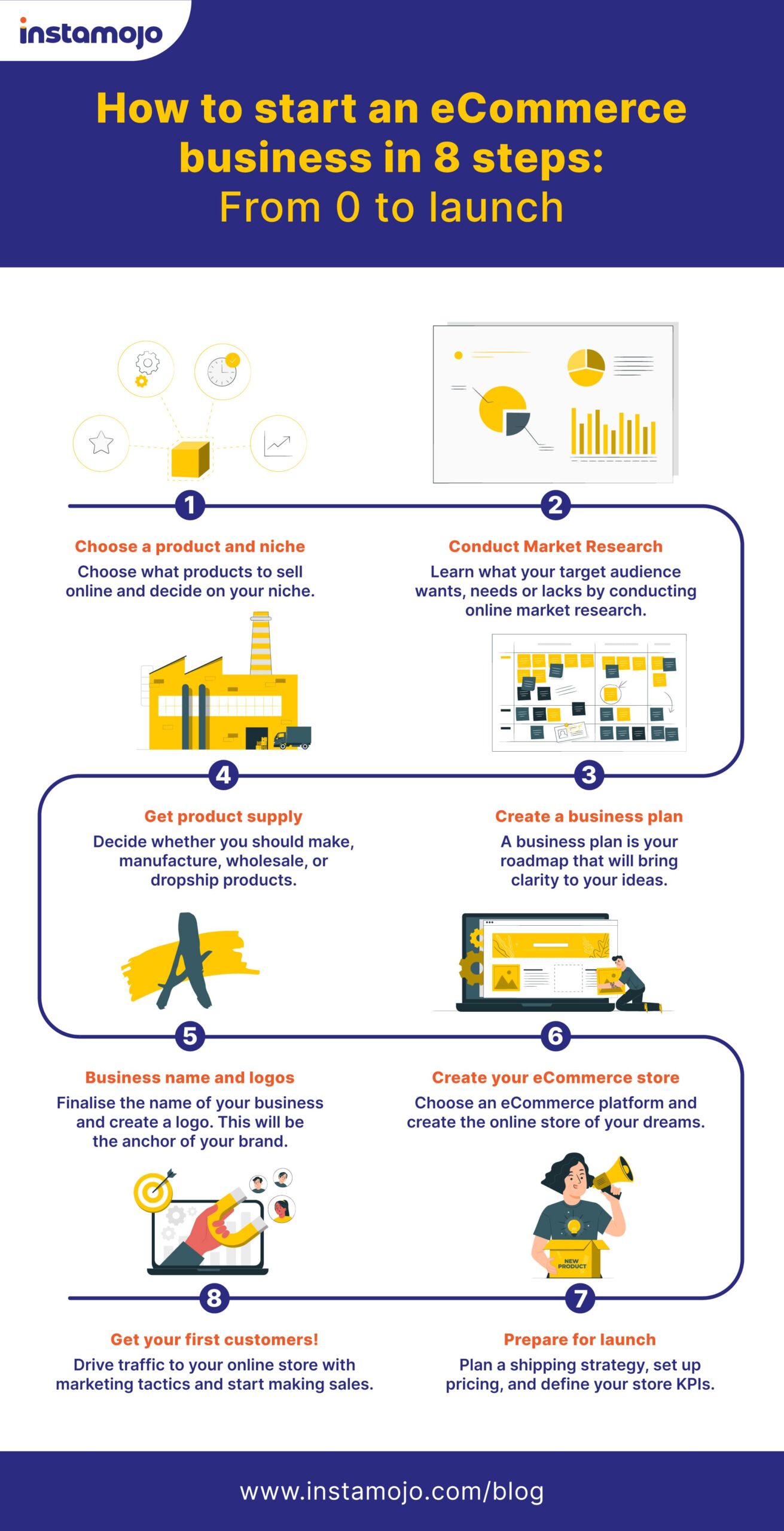
Step 1: Determine niche & products
Choosing the right products is crucial for the success of your business. But how do you determine if your products will be profitable enough? Consider these three points before selecting a product to sell:
- Does the product solve a problem?
- How constant is the product demand?
- Is the market too saturated?
For an eCommerce business to thrive, you need to focus not just on the products, but the niche as well.
In simple words, niche is the category of products you sell and helps define your target audience .
For example, if you decide to sell kitchenware, ’coffee mugs’ is a niche. You can further divide it into sub-niches. The more you niche down, the better chances your brand has to stand out.
Different kinds of products to sell online
Wondering what to sell online ? You can sell three main types of products – physical, digital, and services.
1. Physical goods
Material goods that you either need to source or manufacture are physical products. They are the most common form of products bought and sold online. You can sell anything from art and clothes to grocery and plants .
2. Digital products
The digital products are the one that could be downloaded from the internet. These include ebooks , templates , graphics and other such virtual products. Moreover, you should have knowledge on how to sell digital products online .
Step 2: Conduct market research
To determine if your business idea has enough scope to succeed and grow, you need to conduct market research. We know that the term makes it seem complicated and technical. Here’s how you can conduct a market research in easy ways:
1. Google search
Search for related products and find keywords. Check the different variants of product names and descriptions. For example, if you want to sell ‘macrame items’ online, you need to find out what they search to get those products. They search for ‘wall hangings’.
2. Competitor research
Which brands are well-known in your niche? What is their business model and marketing approach? And how does your product differ from theirs? This is what you can grab through the competitor research.
3. Define your target audience
You need to know who you’re selling to before you start selling. Define your ideal buyer and their pain points. This will help you set a perfect target audience and could assist you with the accurate strategy of niche marketing .
Step 3: Create a business plan
Before setting up the products in your online store, it is more important to set a business plan. Creating a business plan will give you clarity.
Here’s what you can put into a business plan:
- Execution plan
- Marketing and sales
- Finance and funding
Let’s make it easy to understand. This is how you can start with a business plan:
Step 4: Sourcing products
You have three main ways to get hold of products to start your eCommerce business . Each way has its pros and cons.
1. Make your own products
This is most common when selling digital products. For physical products, you need to source raw materials and bear the costs of manufacturing. The advantage is that, your products would be unique and stand out from competition.
2. Wholesale
You can buy products in bulk by partnering with a manufacturer or supplier. Some of the top wholesale distributors in India are Indiamart, Shopclues, and TradeIndia.
3. Find a dropshipper
Dropshipping is a business model which allows you to sell without keeping an inventory of products. Since you don’t have to do shipping and order managing, you can run a business with little investment . The disadvantage is that you have lesser authority.
Step 5: Find business name and logo
Choosing a brand name is an exciting and important part of your business. You need to find a name for your brand.
Here are some points to keep in mind when selecting a name for your eCommerce business:
- Easy to remember
- Makes sense and grabs interest
- Check for available domain names
Your logo is part of your brand’s identity — it’s one of the first things people recognise and remember. Check out these blogs to find a suitable business name and create a logo:
Step 6: Create an eCommerce website
If you have found a product and a business name, the initial stage of starting an online business is done!
The next step is to get your plans to become reality.
For that, you need to set up a storefront where you can do business. You need an eCommerce store where you can not only sell products , but also run your whole business — from customer acquisition to shipping and fulfilment.

The easiest way to create an eCommerce store is through an eCommerce platform like Instamojo. You can get your own customised online store and could start selling instantly.
All you have to do is setting up your premium store with Instamojo, and your store is ready with all the customised features and numerous unique themes . After that, add the products to your store, and it is ready for the next step.
Also, this is a bundle of elements you can enjoy with Instamojo online store.
Step 7: What license is required for eCommerce?
Alright, so now let’s talk about a super important step in getting your eCommerce business off the ground in India – getting the license. Here’s the lowdown on how to do it:
- Grab your Director’s Identification Number (DIN) from the Ministry of Corporate Affairs website.
- Have your PAN card and digital signature ready for the application.
- Check the availability of your brand name with the Registrar of Companies (ROC) or on the Ministry of Corporate Affairs website.
- Once the name is confirmed, apply for GST certification, Professional Tax (PT), and the Shops and Establishment License.
- Wrap it up by applying for the Certification of Company Incorporation under the Company’s Act.
And there you go, you’re set to roll!
Step 8: Prepare for launch
Upon completing the setup of your online store, it’s time to gear up for the launch of your online business.
Before your online store becomes accessible to the public, there are a few crucial tasks to address.
- Ensuring the saleability of your products online requires having high-quality product photographs .
- Accurate and compelling product descriptions .
To have a quick look on how to get a perfect store ready photographs, check out our reel.
Learning about the basics of eCommerce SEO and applying it on your eCommerce store is important to get your store found on search results. So, you need to take care of your eCommerce website’s SEO before launch.
Shipping is an essential part of eCommerce businesses as it determines its success and also accounts for significant cost.
With Instamojo, you can use auto shipment tracking. This is how you can do it! Checkout the video for reference.
Step 9: Get your first customer
Once your store is live, get ready to bring in your first customer . That’s where digital marketing and social media comes into play.
Marketing your business simply means putting it out there before the right people. This is how to do it!
How do you calculate eCommerce profit?
Profit=Total Revenue−Total Costs
In this formula:
- Total Revenue includes the money earned from sales.
- Total Costs encompass all the expenses related to the eCommerce business, such as product costs, website development, marketing, logistics, taxes, and fees.
So, by subtracting your total costs from your total revenue, you get the profit (or loss) of your eCommerce venture. Keep those numbers in check to see how well your business is doing!
From setup to sales: Create your online store with Instamojo
Business can’t be taught. You need to take the first step and figure out the rest on the way. But for starting out, Instamojo holds your back.
Starting your eCommerce business is expanding the idea you have in mind, pitch it to Instamojo and your beautiful online store with a perfect theme will be ready.
What are you waiting for now? Sign up on Instamojo and unlock the best eCommerce experience — features that make you profit and helps you run your business easily.
Start your own eCommerce store
- business to business e commerce
- eCommerce business
- eCommerce business ideas
- ecommerce store
- how can i start an eCommerce business in india for beginners
- how do i start an eCommerce business from home
- how do you calculate eCommerce profit
- how much does it cost to start an eCommerce business in India
- how to create ecommerce website
- how to create my own online store
- How to start an eCommerce business
- how to start ecommerce business in india
- how to start online business from home
- is eCommerce profitable
- online selling business
- process of e commerce
- starting an online business
- what is an e commerce company
- what is e commerce business
- what is the highest paid ECOM niche
- what is the profit margin for ECOM
- what license is required for eCommerce
Hibathu Naseer
Leave a reply cancel reply.
Your email address will not be published. Required fields are marked *
Save my name, email, and website in this browser for the next time I comment.
This site uses Akismet to reduce spam. Learn how your comment data is processed .
4 D2C eCommerce marketing campaigns that made our hearts flutter
7 smart brands using smart landing pages to grow online.
- Online Store
- Online Store Setup
- Online Payments
- Smart Pages
- Payment Links
- Smart links
- Embed Payment Button
- Faster Payouts
- eCommerce Mobile App
- Instamojo App Store
- Bank Transfer
- Convenience Fee
- mojoPlus Rewards
- API & Plugins
- Documentation
- Mojo Developers Program
- Marketplace API
- Blog Categories
- Instamojo Product Guide
- Instamojo Team Speaks
- eCommerce Business Advice
- eCommerce Success Stories
- eCommerce News
- How To Sell Online
- Clothing & Accessories
- Art & Craft
- Furniture & Home Decor
- Food & Beverage
- Health & Beauty
- Jewellery & Accessories
- mojoVersity
- Business Communities
- Customer Stories
- Become a Partners
- Refer & Earn
- ● System Status
- Keep In Touch
Instamojo is an all-in-one Indian #D2CTech platform. We power independent eCommerce brands and startups with online stores, landing pages and payment solutions to help every seller start, manage and scale their online business successfully.
© 2024, Instamojo | Terms of Service | Privacy | Write for Us
- Business Performance Improvement
- Legal Compliances
- Market Linkage
- Newsletters
- Professional Services
- Proposal Creation & Funding
- Research & Policy advocacy
- Yashaswi Udyojak
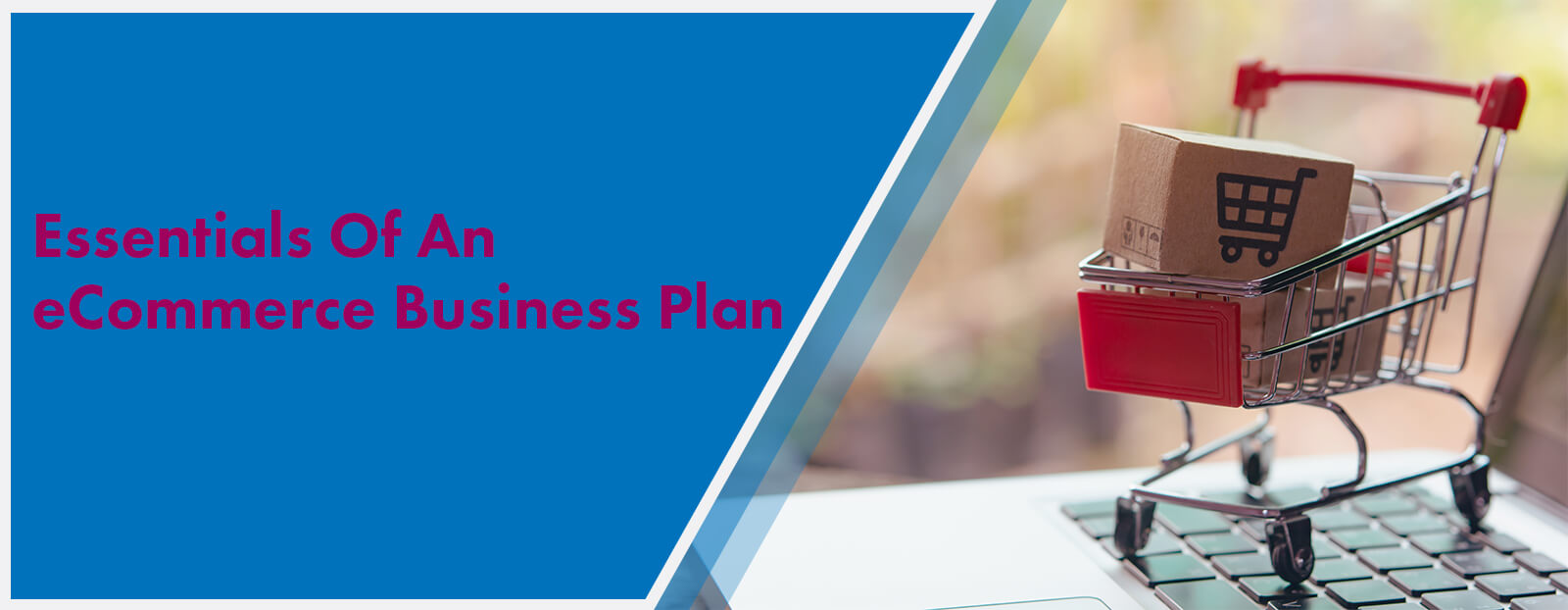
Essentials Of An eCommerce Business Plan
E-commerce is now a way of life and a part of our daily life. The reach and influence of e-commerce in our lives can be roughly estimated by just considering the fact that every single person must be using a minimum of one digital media application or an e-commerce platform every single day for their shopping and business needs. E-commerce is thus an integral and important aspect of how business is done in the present times and is most likely to shape the future methods of carrying out business too. Therefore, entrepreneurs aspiring to explore e-commerce business opportunities are looking at the right business idea which is rewarding and is also in sync with the current trend and demand, as it embraces technology as well as convenience.
E-commerce business typically covers all the businesses that are conducted over the internet where the transactions between the consumer and dealer are also carried out online. It could include websites, e-stores, certain service applications but chiefly it refers to platforms that allow dealers to sell products online . As compared to traditional businesses, an e-commerce business has several advantages, thus encouraging more entrepreneurs to consider it as a business opportunity. Some of the benefits of an E-commerce business include-
- E-commerce business provides goods and services at a comparatively lower cost. The lowered cost is partly because the cost of procuring a physical location, investing in a property, maintaining stock, day to day expenses like electricity, salaries, maintenance, repairs, etc are saved when the business is online and these savings can then be passed on to the consumers.
- An e-commerce business has a worldwide reach and overcomes the physical and geographical barriers that can restrict a physical shop. The reach of the business throughout the world also increases the target audience and the customer base of the e-commerce platform and business, thus benefiting the business.
- An e-commerce business provides the users or customers with complete information regarding the products, which might not be possible for a physical store to provide, given the space and display restrictions. In comparison, E-commerce businesses can make additional information easily available to customers. Also, most of this information is provided by vendors who use the e-commerce platform to display and sell their products and therefore it does not cost the e-commerce business itself anything to create or maintain the information and data. Customers can thus make informed decisions while purchasing products or services via e-commerce businesses.
- E-commerce platforms allow consumers to compare and choose from a wide variety of options for the same type of products. This choice and ability to compare is not possible in a physical store, thus making e-commerce platforms even more popular and in demand.
These are just some of the benefits of starting an E-commerce business, both for the entrepreneur and for the consumers.
However, before starting the business, it is important to plan the business. Business planning involves having a written document with the goals, objectives and the vision of the business. A business plan also outlines the methods and steps that will be undertaken to achieve the goals as well as a rough time frame within which the business plans to achieve these goals. Further, an e-commerce business plan is especially important, given that an increasing number of shoppers are conducting their business online.
An ecommerce business plan defines and directs the various factors that go into an online business platform’s launch and continued growth. Also, an ecommerce business plan helps the entrepreneur remain organized and is also useful when seeking investors who need to understand the company and its business method. Many entrepreneurs believe that since the e-commerce business is operated via a platform and all the transactions happen online, procuring funding is the major factor to be concerned about and be included in the business plan but for most ecommerce businesses, the management of startup funds plays a surprisingly minor role in the overall plan. Instead, there are several other aspects that need to be considered while starting an e-commerce business and in order to be aware of these vital factors, a business planning checklist can be referred to for guidance while devising an e-commerce business plan.

Ecommerce Business Plan
The core framework of every business plan, including the business plan for an ecommerce startup consists of
- The executive summary
- The company or business description
- The management and operations description
- The market analysis
- The competition analysis
- The marketing and sales description
- The financial summary
All the information regarding the business will be included under the above mentioned topics for the ecommerce business plan. However, what is the vital information regarding the ecommerce business that needs to be included under these topics in the e-commerce business plan also needs to be known. Some of the essential details that need to be included in the plan are discussed here.
Business And Sales Model
An ecommerce business is a broad term that encompasses a number of business models under it, but basically it is an online platform, that is started by the entrepreneur, that provides a channel to all vendors and dealers to sell their products and services through it. It can further include an e-store or a mobile application or a subscription site, etc. The model types can either be delivery of stocked goods or drop-ship items or manufacturing made-on-order products or even digital downloads, as there are plenty of selling options in an ecommerce business. Thus, entrepreneurs starting an ecommerce platform must decide which types of product or products they wish to sell via the ecommerce business. If not produce the items themselves, then entrepreneurs must identify suppliers, who can either be wholesale, drop-ship, or print-on-demand vendors. Further the entrepreneurs even need to consider the budget in upfront and ongoing manufacturing, wholesale, or other production costs where applicable. In case of digital products, the entrepreneurs need to identify software needed to produce digital files for distribution.
Additionally, the sales of an ecommerce business can either be done in the form of an online store on an ecommerce platform or through an online store on a blogging platform or through a marketplace such as those provided by sites like Amazon (which sells variety of products) or Etsy (which sells artisanal or handmade products) or eBay (which sells products via auctions) or selling products via social media accounts, which is known as social selling.
Entrepreneurs must therefore decide on the business as well as sales model for their ecommerce business and mention it explicitly in their ecomerce business plan.
Marketing Model
An e-commerce platform needs to plan their marketing strategy in greater detail considering that several other vendors might also be relying on the marketing and advertising plans of the business. Since the e-commerce business is primarily online, the marketing plans for the business must also be strategized via online channels. It could be either via emails, social media advertising and posts, search based advertising such as
Google advertising, and also print advertising can be employed. The marketing plan, the launch and estimated timeline of the program and the budget for the marketing plan must be included in the ecommerce business plan.
Capital Requirement And Procurement
The business plan for an e-commerce startup must include information regarding the capital required for starting the business as well as how the required capital will be procured. The chief requirements of the e-commerce business include investment to set up the digital platform- the coding, the programming, the interface, the connectivity, the data creation and storage and various other technical aspects which will make the platform easy to use for the suppliers and the customers alike. Similarly, entrepreneurs need to enable a secure and reliable payment gateways as well as handle other aspects of selling their products (or services) or those of other vendors on the platform. The marketing and advertising plan also requires funding. There are several other miscellaneous expenses while setting up an e-commerce business platform.
The funding for all these expenses can be sought via bank loans or loans from non-banking financial institutions or even through investors. The exact capital requirement, along with a detailed break-up of the costs must be included in the business plan, along with the plans to procure the funding. The plan is also presented to lending institutes thus the financial requirements and the plans must be mentioned explicitly in the ecommerce business plan.
Irrespective of what the ecommerce dreams of the entrepreneur include and where they take the entrepreneur, a sound business plan helps map the entire process. Some ecommerce business plans might involve startup costs and funding distribution, while other plans, such as those for digital sellers and drop-shippers, might focus on sales channel and marketing outreach, where the operating costs are a minimal factor. Whatever may be the path that the e-commerce business platform takes, a sound plan provides solid footing and to design a solid business plan, assistance from deAsra Foundation can be sought. The experts at deAsra along with the entrepreneur’s vision will help the e-commerce business take off on promising note.
Building Networks and Support Systems: The Importance of Women’s Entrepreneurial Communities
In the world of entrepreneurship, where challenges and opportunities coexist, the power of community cannot be overstated. This sentiment rings even truer for women entrepreneurs, especially in India....
Why Indian Sellers Should Join the ONDC Network
In an era of digital transformation, Indian sellers are continually looking for platforms that not only enhance their market reach but also streamline their business operations. The Open Network for D...
Empowering Women at Home – Top 6 Work from Home Business Ideas for Housewives
In today's dynamic world, the concept of entrepreneurship has dramatically evolved, opening doors to numerous opportunities, especially for housewives looking to step into the business realm. With the...
Join the Celebration: deAsra’s Entrepreneur Excellence Awards 2024 – Support and Inspire
As the calendar flips to 2024, the entrepreneurial spirit among women in India will be celebrated grandly through deAsra Foundation's Entrepreneur Excellence Awards. This prestigious event not only sp...
Navigating ONDC: A Step-by-Step Guide for Sellers
The Open Network for Digital Commerce, or ONDC, is setting a new precedent in the e-commerce landscape of India, offering a unique platform for sellers across the country. This innovative initiative a...
Leave a Reply Cancel reply
Your email address will not be published. Required fields are marked *
Step 1 of 2
All fields marked* are mandatory
To continue reading further, please provide us the below details
- Name * First Last
- Country Code *
- Facilitator Email
- External Handholder Email
- Selected Service
- EHH Engaged Consent Stay Engaged with EHH only
- LS Response
- Business Rule
- Response Message
- UTM Campaign

wrong OTP try again!!
Home » Earn Online » 12 Steps to Start your own eCommerce business in India (2024 Edition)
12 Steps to Start your own eCommerce business in India (2024 Edition)

Table of Contents
Digitization has revolutionized the whole world. Whether making payments, online shopping or pursuing education, everything is possible with a mouse click. Many organizations or companies are shifting business online. The most prominent example is the emergence of the eCommerce sector. E-commerce is also known as electronic commerce. So, whenever anyone is engaged in buying or selling goods or services online, they are involved in e-commerce. This article presents a guide to start an eCommerce business in India, covering necessary steps and FAQs.
Why start an eCommerce business?
The Ecommerce sector is one of the most significant sectors in India. The market size of Ecommerce was $64 billion initially in 2020 but is expected to cross by $200 billion by 2027-28 as shared by India Brand equity foundation [1] . The reason is that, after the pandemic, more and more people prefer online shopping.
Ecommerce is one of the biggest industries expected to usher in the next wave of the Indian economy. According to recent United Nations Conference on Trade and Development studies, the eCommerce sector will rise worldwide from $2.86 trillion to $27 trillion by 2020. All thanks to internet usage and the rising popularity of smartphones. As it is one of the booming sectors, running an eCommerce business can be a great source of income. Other vital reasons to start an eCommerce business are mentioned as follows:
1. Make sales and purchases on your terms
When a person is running a brick-and-mortar store, location is one of the essential things to consider. But to start an eCommerce business, there are no such constraints; through approaching the right digital marketing strategy, one can expand their business across the globe.
2. Affordable
Running a traditional store costs more than an eCommerce store concerning inventory, design, etc. To start an eCommerce business, one does not require much investment. However, it is not free. It requires buying a domain name and designing a website but accomplishing all these tasks requires the bare minimum.
3. Get access to a vast customer base
Running an eCommerce business makes entrepreneurs enjoy an enormous customer base. There are so many social media platforms available where one can promote their website on various channels like mobile apps, marketplaces like eBay and Amazon, or on social media channels like Instagram and Facebook.
4. Offer Convenience
Ecommerce platforms offer convenience to both buyers and sellers. One can start an eCommerce business from the comfort of the home. It is operational 24×7. So, one enjoys considerable sales in the eCommerce business compared to traditional stores that are operational for a maximum of 10-12 hours.
5. Personalized customer service
A survey conducted by Epsilon reveals that 80% of customers prefer those who offer them personalized shopping experiences through loyalty programs, promotional offers, customized recommendations, and communications.
6. eCommerce makes a business go global
Traditional stores are limited by geographical area but starting an eCommerce business offers an opportunity of increasing outreach. A person can submit their products and services to their target audience globally. It eliminates all types of linguistic and geographical barriers. Best way to make a business global!
Related Article: Building a Business Website? 8 Key Steps To Building Small Business Website
12 Steps to start an eCommerce business in India
Before beginning with the steps, here are some important aspects to keep in mind to start an eCommerce business:
- Pricing and product quality
- Customer engagement
- Data security
- Promoting business through pop-up ads and sites
- Timely delivery of products
There are many benefits associated with running an eCommerce business. The eCommerce reach is more, and listing products is quite simple. To sell products online, two choices are open to each person; one involves listing products on marketplaces, and another involves building a personal eCommerce store. After carefully thinking about these aspects, follow the steps below to start an eCommerce business.
Step 1: Determine niche and products
When planning to start an eCommerce business in India, choosing the right product for the company is the most important thing. When one is selecting a product, keep these factors in mind:
- Is the selected product in demand?
- Is it seasonal or remains all-time in demand?
- Research about the competitors
Apart from the products, it would help to focus on a niche in an eCommerce business. It is a category under which a product falls, as it plays a crucial role in defining a target audience.
Step 2: Conduct market research
To start an eCommerce business in India, begin by researching different business models, top competitors, and trending products. It helps in making a well-thought-out business plan. One should explore finding gaps in the market in which one can work and make their eCommerce brand unique. While doing research, factors that need to be taken care of include:
- Market size
- Market Trends
- Gaps in Financing
- Market Size
Step 3: Create a business plan
Creating a wise e-commerce business plan is the next step to start an eCommerce business. Once a business model has been chosen, the next step involves building the business. Choose a unique name brand and finalize a brand logo. It is essential to beware of the legal and financial consequences of the business entity one is selecting.
The most common business entity forms are limited liability partnership, private limited company, sole proprietorship, and single-person company. Different aspects need to be covered when creating a business plan, such as choosing a payment method, drafting customer service policies, devising a social media strategy, etc. All of them are listed as follows:
Step 4: Choose payment methods
To run a successful eCommerce business, one must select payment methods. One needs to develop a fully functioning online store. Payment methods come in various sizes and shapes. Always choose a payment
To run a successful eCommerce business, one must select payment methods. One needs to develop a fully functioning online store. Payment methods come in various sizes and shapes. Always choose a payment method that fits well with the company’s essence. Some of the most popular eCommerce payment procedures are:
- Credit card/ Debit card- Card payments are one of the most common payment modes available nationally and internationally. It works as a global payment solution on an eCommerce platform. Credit card and debit card payments are considered convenient and safe options. The customer must enter the card number, expiration date, and CVV. Any customer doing online shopping and prefers to do that under budget always chooses debit cards.
- E-Wallet- Another popular payment mode that gives a new shopping experience. E-Wallets are gaining popularity at a breakneck rate. Every eCommerce platform has an option to set an Ewallet option. This e-wallet is usually connected to a bank account. This entire payment process is fast and instant. It is also known as an instant digital payment process.
- Bank Transfer- One of the all-time standard bank transfer processes. It is also known as a fallback payment mechanism. In some eCommerce stores, you find this option also. One of the safest modes of making payments.
- Cash on delivery- If one is starting any eCommerce business in India, it is a must to add this option. Initially, when you start a business, the customer hardly goes with the prepaid order options. So this option minimizes the chances of abandoned cart recovery.
Step 5: Draft a solid social media strategy
One must have a strong online media presence to start an eCommerce business. Draft a solid social media strategy and choose platforms wisely.
- SEO Strategy- It is also known as Search Engine Optimization. The more optimized your eCommerce site, the better it will rank on Google. One of the effective digital marketing strategies to boost traffic and sale on eCommerce platforms. One should know keywords to increase your eCommerce platform.
- Social Media – When planning to start an eCommerce business in India, building a brand’s online presence is a must. Nowadays, we live in a digital era, where anyone buying anything is checking google reviews or product reviews. One can also opt for good influencer marketing strategies to promote your products and services. One can start with publishing links and posting content about products or services that attract their target audiences.
- Promotions- It is also one of the effective digital marketing strategies to follow when starting an eCommerce business in India. It is a significant way of promoting every start-up. One can offer them discounts on first purchases so that customers flock to the newly established eCommerce store.
- Advertisements- Paid advertisements nowadays are very expensive, to widen the reach of a newly established eCommerce store, and sustain high conversion rates. Pay-per-click advertisements are one of the most paid advertising strategies enabling one to compensate each time one clicks on a link. If there is the right integration of the user interface and conversion process, it will get positive results quickly.
Step 6: Customer service
Being an eCommerce company, the logistic organization one chooses should have effective communication channels. Must ensure they are promptly responding to phone calls.
Step 7: Sourcing products
Choosing the right logistic partner is essential to start an eCommerce business in India.
Online business works well on timely delivery of products and services. Selecting the right logistic partner is a must for enjoying consistent and efficient tracking of goods and services. The brand image is dependent mainly on the logistics provider. Factors to consider while choosing the right logistic partner.
Another important thing to consider when selecting a logistics partner is pricing. Always select what fits your budget and deliver products to customers to ensure client loyalty. Choosing the correct supplier for specific products is another critical task when starting an eCommerce business.
Step 8: Freight management
- Always choose a logistics company that specializes in freight management. A logistic company that adapts well to the changing needs of the eCommerce industry. Ensure that the company you select can handle 3PLs efficiently and quickly.
- Technology- Choose a company that makes use of cutting-edge technology for product delivery. Offer always groundbreaking and personalized solutions.
- Scalability- The ideal logistic partner increases the reach of a company. Can manage solutions and services efficiently.
- Costing- Another essential factor to consider while choosing a logistic partner is cost. Always choose what fits with your budgeting and deliver products to the customer ensuring customer loyalty.
Step 9: Find the business name and logo
Whenever one decides to start an eCommerce business in India, the most challenging is naming a store and creating a logo representing that name. One needs to choose a name and logo that catches the eye of the target audience.
There are a couple of platforms that can help one establish their brand. Another vital part is choosing the right eCommerce platform to establish one’s business. The eCommerce platform market is enormous. There are many options available; choosing the one that fits well with one’s nature of business is key. Some of the most popular eCommerce platforms are:
- Shopify plus
- BigCommerce
- WooCommerce
- Invent Suit
Step 10: Create an eCommerce website
The next step is to create a working website that customers can access. The key is to offer a user-friendly experience with great service. When one plans to start an eCommerce business, getting in touch with various development companies to build the website is the next important step. While choosing the one, keep in mind all these factors:
- Persona; business goals
- Selected technology partner’s expertise
- The developing partner is equipped with an experienced and skilled team
- Scaling ability
- Brand growth
- Work process
- Reliability
Try to add mascots on the sites that guide users and makes their shopping seamless. It is only possible when one chooses a simple and user-friendly interface.
Step 11: Customizing an eCommerce platform
There are various procedures, technology, and ways of building an eCommerce platform. One is required to understand the requirements and scalability of the business. But before making an eCommerce platform, it is a must to evaluate one’s needs in terms of:
- Domain name
- Hosting Provider
- Designing of eCommerce store
- Obtaining SSLC certificate
- Payment gateways
- Choosing your logistic partner
Step 12: Prepare for the launch
The final step to start an eCommerce business involves taking charge of a couple of essential things, but not thought about enough during the initial stages.
Must have a separate business account
When one is planning to start an eCommerce business in India, it is a must to do GST registrations. It is mandatory to have a GST number for all eCommerce businesses regardless of the sales turnover.
Doing tax registrations
If one. is planning to start an eCommerce business, make sure to have a separate business account for a smooth business operation. Never mix a personal account with a business account. Here are some of the legal formalities for operating an eCommerce business in India:
- Mention the DIN number of the company’s director; one can download the same from Corporate Affairs Websites or by filling DIN application form.
- Ascertain that you own your permanent account number and digital signature certificate.
- Once you download the DIN, get in touch with the Registrar of Companies to inquire about the availability of the company name, it should not be the copyright of any other company.
- Post that, apply for a GST certificate
Also, read: How to Sell Products Online and Start an Online Store?
Start an eCommerce business now!
As the eCommerce industry is booming, building one’s own eCommerce business is a great idea. Make sure to keep all the above-listed steps in mind and follow through.

Chegg hiring offers the opportunities to gain tremendous exposure to the corporate world, helps connect with different industry experts, and creates a solid peer network. All one has to do is sign up!
Frequently Asked Questions
Starting an eCommerce business is not very tough because platforms like Shopify enable different brands to go online quickly. However, running a successful eCommerce business requires consistency, hard work, and continuous market research to keep updating your products and services.
The three types of eCommerce include: 1. Business-to-Business: Business-to-business, or b2b , is the procedure of selling online from one business to another. it’s like setting up a wholesale business. 2. Business-to-Consumer: Nowadays, a lot of e-commerce is b2c , as it has become easier for businesses to target specific customers online. Businesses can display their products/services online, and customers can easily order them using their smartphones. 3. Consumer-to-Consumer: Sometimes customers buy many products, don’t know what to do with them, and don’t find the time to return them to the retailer. websites like eBay allow the customer to upload images of the products and sell them online to other customers interested in the same product.
A business plan is a must if you plan to start an eCommerce business in India. Your mission and vision get clearer with a business plan. Establishing a business plan includes deciding what products to offer, selecting a supplier, choosing a logistics partner, deciding a social media strategy, drafting customer service policies, etc. Warehousing, product storage, the nature of your eCommerce business, and sourcing are some other significant components of building an eCommerce store.
The Ecommerce sector is one of the most significant sectors in India. The market size of Ecommerce was $64 billion initially in 2020 but is expected to cross by $200 billion by 2027-28 as shared by India Brand equity foundation. Hence, it is worth getting into eCommerce, but before you begin consider what products you want to sell or services you want to offer, and conduct thorough market research.
Ecommerce is one of the most important industries that will usher in the next phase of the Indian economy. According to recent United Nations Conference on Trade and Development estimates, the global eCommerce sector would grow from $2.86 trillion to $27 trillion by 2020. All thanks to increased internet usage and smartphone popularity. Running an eCommerce business can be a wonderful source of revenue because it is one of the booming industries.
Here are some useful resources:
- What is Drop shipping and Why is it Trending?
- Steps for Creating the Best Online Business Plan
Start Online Q&A Business
To read more related articles, click here.
Got a question on this topic?
Related Articles
Start q&a business online.
- Privacy Policy
- Chegg Study
- Learn a language
- Writing Support
- Expert Hiring and Payment Dashboard
- पैसे कैसे कमाए? Earn Online
- Career Guidance
- General Knowledge
- Web Stories
Chegg India does not ask for money to offer any opportunity with the company. We request you to be vigilant before sharing your personal and financial information with any third party. Beware of fraudulent activities claiming affiliation with our company and promising monetary rewards or benefits. Chegg India shall not be responsible for any losses resulting from such activities.
- Chegg Inc. Compliance
© 2024 Chegg Inc. All rights reserved.
- Recent Searches
- Trending News

- Latest Updates
Web Stories
Today's E-Paper

Hello, Health!
- Latest News

Pride Month

View All Latest

- Subscribe to Mid-Day Gold
- Subscribe to E-paper
- Premium stories from Sunday Mid-Day
- Best Value Deal!
Mother's Day
Father's Day

- Mid-Day Gold
- Mumbai News
- Mumbai Crime News
- Mumbai Rains
- Offbeat News
- Opinion News
- Bollywood News
- Web Series News
- Hollywood News
- Television News
- Regional Indian Cinema News
- Korean Entertainment News
- Cricket News
- Football News
- Other Sports News
- Fashion News
- Culture News
- Travel News
- Health & Fitness News
- Relationships News
- Infotainment News
- Nature & Wildlife News
Mid-Day Web Stories
- Sunday Mid-Day
- Mumbai Food News
- Things to do News
- Famous Personalities News
- BM Text Drops
- Critical Care Hospital Survey
- Multispecialty Hospital Survey
- Elections 2024
- News for You
- Careers at Mid-Day
Trending Now
How to start an e-commerce business in India: The step-by-step guide
Updated on: 16 September,2022 08:59 PM IST | Mumbai BrandMedia | [email protected]
- Text

Are you dreaming of starting your own eCommerce business but don't know where to start? Well, fear not! In this blog post, we're going to outline the whole process of starting an eCommerce business in India, from beginning to end.
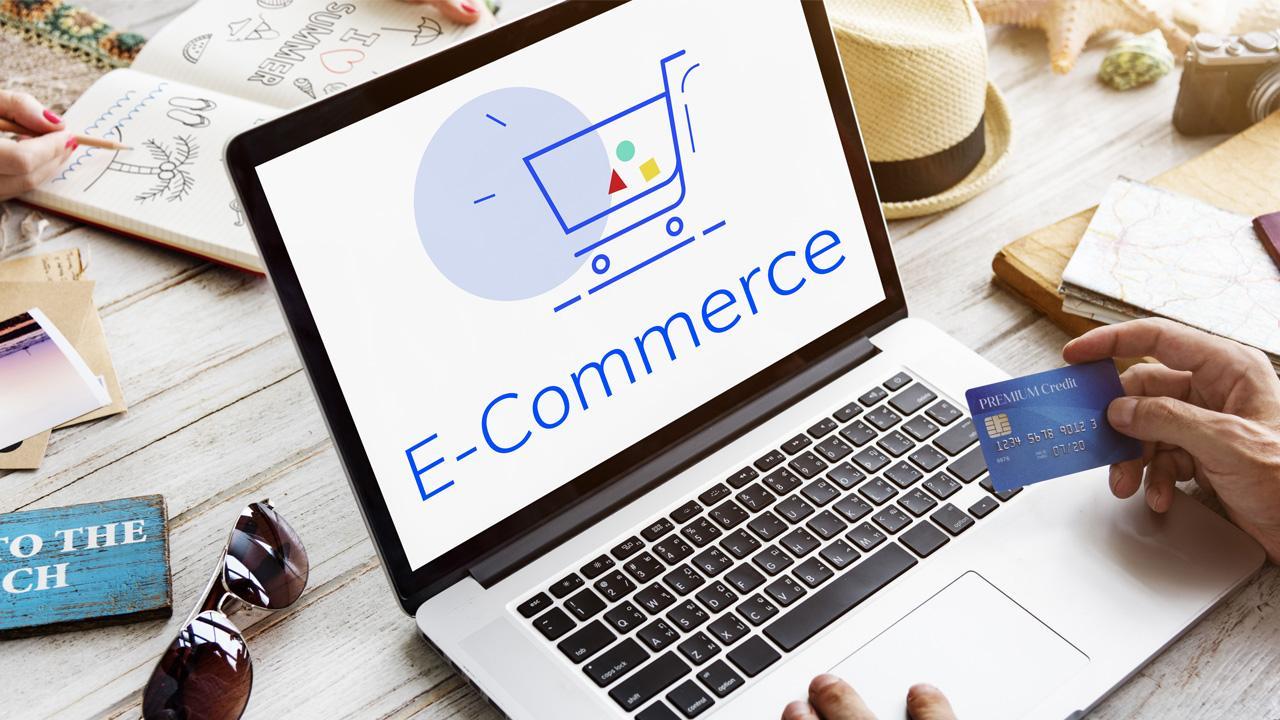
From coming up with a business plan to launching your website, we'll make sure that everything is step-by-step and easy to follow. So if eCommerce is something that interests you, read on and get started!
Step 1: Know Your Business Plan and Model
ADVERTISEMENT
Starting an e-commerce business in India can be a great opportunity for entrepreneurs of all levels of experience and skill. However, it is important to be aware of the various factors that can affect business success. That's why it's crucial to develop a strong business strategy and model from the get-go. Make sure you research the different e-commerce platforms available before making a decision. Once you've chosen the right platform, it's time to develop a clear business plan and model. This will help you make informed decisions, stay on track, and reach your business goals.
Currently, there are two options available to kick-start an eCommerce business, the first being a proprietary eCommerce website, and the second being an established marketplace.
Let us understand the difference between the two:
A. The Proprietary eCommerce website:
- This is one of the hardest ways of starting an eCommerce business. To start this one would need a strong web development team, backed by an online marketing team, and a payment gateway to collect payments with ease.
- Those interested to start an eCommerce business should understand that this would take a great amount of investment, all for the long-term initiative.
B. Established Marketplace:
- Join an established marketplace if looking to kick-start your eCommerce business, or if the plan to sell products or services online.
- This is one of the easiest ways as it requires the sellers to have a bank account and a GST registration. The best part? Everything you would ever need is taken care of, like marketing, technology development, payment gateway, logistics, and more. Some of the top eCommerce marketplaces to look for are Amazon, Flipkart, Snapdeal, and more.
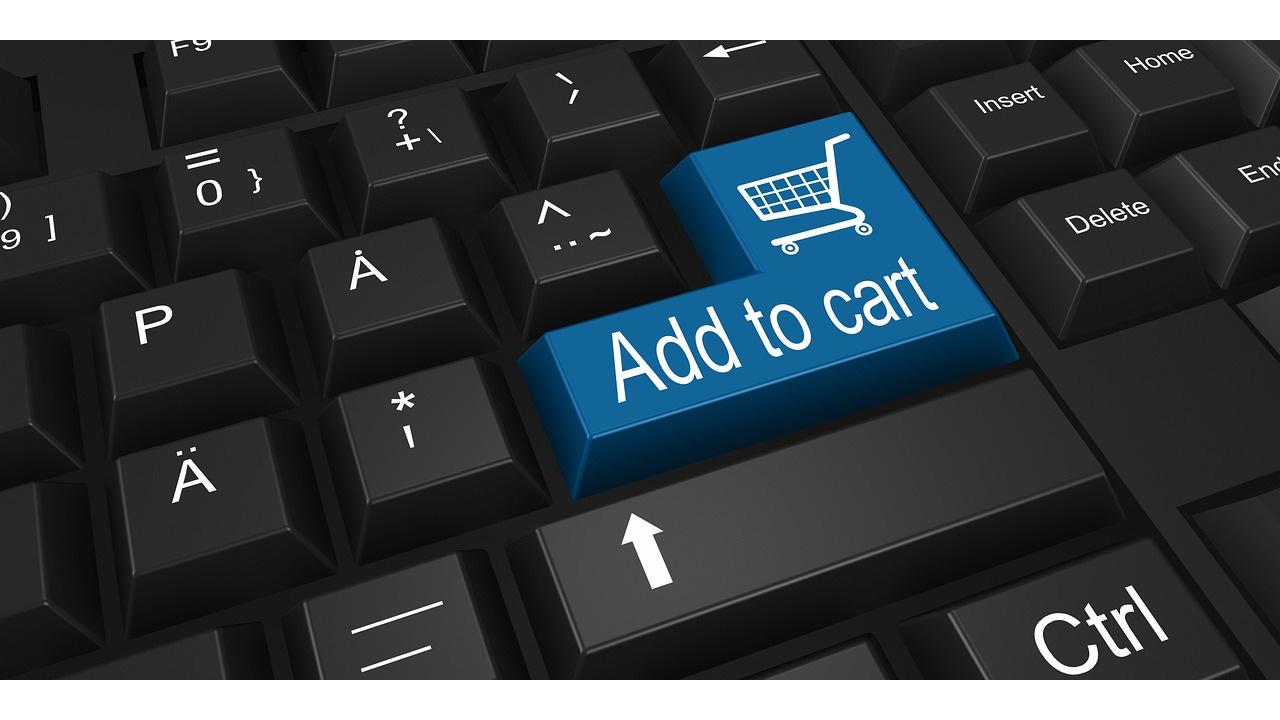
Step 2: Conduct Market Research
Starting and running an e-commerce business in India can be a daunting task. But with the right planning and strategies, it can be a rewarding experience. Before starting your business, it's essential to do some market research. This will help you understand the Indian consumer and their shopping habits. Make sure you have a good understanding of the e-commerce market in India before you start selling so that you're able to succeed in this competitive industry.
Step 3: Brand Your Brand
It's important to brand your business and make it stand out from the competition. This can be done by choosing a name that reflects your business and its values, as well as developing a strong website that provides information about your products. You'll also need to develop marketing campaigns that target the right audience and promote your products in the right way. With the right strategies in place, eCommerce business in India can be a successful venture.
Step 4: Find The Perfect Logo
As soon as you settle on a name, develop a logo that represents your brand and conveys the essence of your business. There are many free and affordable logo software programs available online, so be sure to explore them all. After finding the choice of your design, print out several copies and take them to local businesses for feedback. This will help you get feedback on the design, and make sure it's suitable for your business. Remember to save your original design so you can use it again if needed!
Step 5: eCommerce Business Registration
The next step is to register your business with the government. This will involve filling out several forms, and depending on the business you're setting up, may require a license or other permissions.
Some of the essential ones out there are sole proprietorship, limited liability partnership, single-person company, or a private limited company. Each of these types of businesses has its advantages and disadvantages, but seeking legal advice would be the best choice.
Step 6: A Software For Your Business
This will help you manage your business more efficiently and handle customer inquiries in a better way. There are various software options available, so it's important to shop around and find the best one for your business needs. The right platform will allow you to track sales, keep records of shipping transactions, etc., making e-commerce management much easier.
Step 7: Create An eCommerce Website
It's essential to start on the right foot by creating a website that accurately reflects your brand and product. Make sure all pages load quickly and look professional, no matter the device used. In addition to installing the latest updates, make sure to add images, videos, and other features to enhance the customer experience. You can also choose the design interface that best suits your business and blog style. Once you have everything in place, it's time to start marketing your business online.
Step 8: Open A Bank Account
There are many banks, that offer e-commerce accounts, so it's important to choose the right one for your business. Additionally, make sure to follow all the necessary regulations and taxes that apply to e-commerce businesses in India.
This will help protect you from potential legal issues down the road. Once your bank account is open, wire in some initial funds so you can get started. Keep in mind that e-commerce businesses in India face unique challenges, so it's important to have a business plan that takes these into account.
Note: To get a bank account for your eCommerce business, an Employer Identification Number (EIN) is mandatory. Without this, you cannot operate an eCommerce business.
Step 9: Payment Gateways
There are a variety of payment gateways available, and it's important to choose the one that will best suit your business needs. Post choosing a payment gateway, it's time to set up your merchant account and shipping details. Once everything is set up, it's time to start selling your products and watch the money roll in! Consider using an e-commerce platform like Shopify or Amazon, as they offer built-in payment processing features that make online selling easier. Also, getting a couponing platform like GrabOn is a sure deal, that will drive your business to the next level. Not only does it add value to your business, but helps retain customers, eventually bringing in more sales.
Step 10: Prepare For The Launch
Preparing for launch is all about getting your products ready for launch. This includes designing a product page, pricing scheme, and shipping information. Make sure to plan out your promotional efforts for the launch day! Lastly, create a pricing strategy and begin to build your buyer persona research. By doing this, you will be able to target the right market and maximize your profits.
Step 11: Build A Strong Customer Base
It's important to build a strong customer base. There are a variety of ways to do this, but the most effective approach is to target your target market directly. After building a relationship of trust with your customers, it's time to offer them excellent service and competitive prices. Be creative when promoting your store - people will want to shop from the best! Remember, e-commerce is all about giving customers the best possible experience, so make sure you put your all into it!
Frequently Asked Questions
How do I find the right eCommerce platform for my business?
When it comes to eCommerce, it is important to evaluate which platform best suits your business needs. There are several popular e-commerce platforms in India, including Shopify, Magento, and BigCommerce. Once you have selected a platform, the next step is to create a custom shopfront using themes or templates available online. There are numerous e-commerce platforms that you can choose from, depending on what features and services you need.
What’s the cost of starting an eCommerce store in India?
As to experts, it would cost a minimum of Rs 1 lakh to register for a Private Label Company, and the total cost would depend on the business model or category.
How can I increase my chances of success by optimizing my website for search engines?
There are countless ways to improve the visibility of your site on search engine result pages (SERPs), there are a variety of things you can do. Some of the most common measures that you can take include:
a. Add keywords to your website's name, description, and meta keywords.
b. Make use of meta descriptions to give people a better idea of what your website is all about.
c. Create an easily accessible user experience by designing your website using intuitive design principles.
d. Keep up a good social media presence to let people know about any updates or new content that’s been added to your website.
e. By optimizing your website for search engines, you'll improve the chances of getting visitors from Google and other major browsers.
What are the most important things to consider when starting an e-commerce business in India?
When starting an e-commerce business in India, it is important to have a clear idea of what you want your business to do and what it will look like. Once you have this information, you can begin the process of finding the right technology platform, designing a website that meets the shopping needs of your target audience, and developing a marketing plan that will help your store reach its potential. Additionally, avoid overspending on start-up costs and make sure you have a solid business model in place before launching your store. By doing these things, you will be able to minimize any risks and attain a successful online business in India.
After reading the blog, we are sure you have a better idea of how to launch a successful business. However, there is one thing that needs constant monitoring and focus – customer support. Apart from this, if you also know how to market well and build trust with your target audience, you will be on track for success!
Hope you loved reading the blog post.

Register for FREE to continue reading !
This is not a paywall. however, your registration helps us understand your preferences better and enables us to provide insightful and credible journalism for all our readers., subscribe to newsletter.
Captcha Code
Next Story : Start-Up Stories on “Unfolding the Unicorn Journey - A Game Changer” organised by BRICS CCI with FORE School of Management

Popular Posts
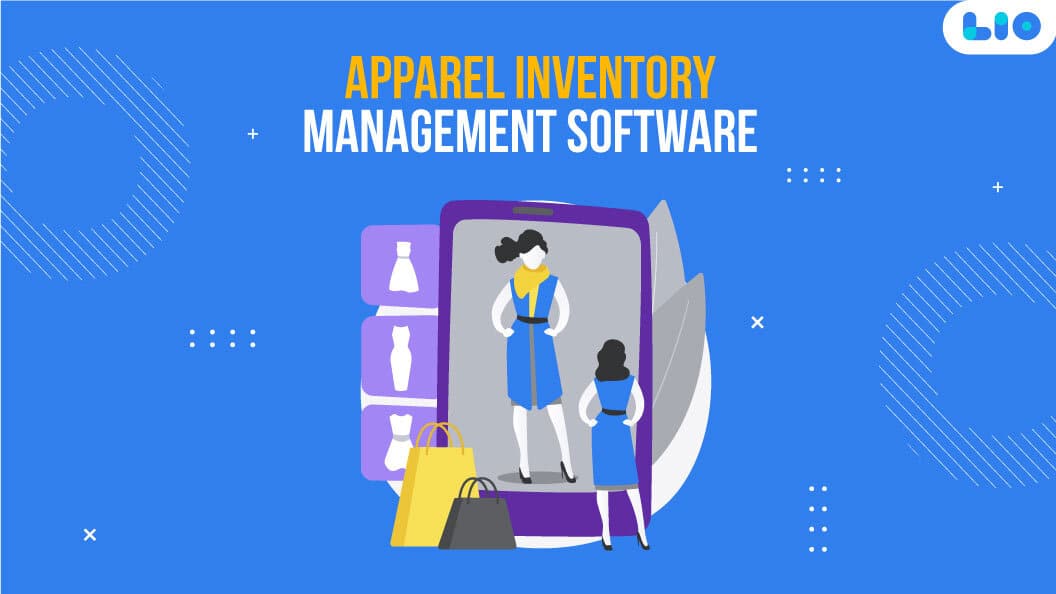
- Streamline Your Apparel Business with Effective Apparel Inventory Management Software
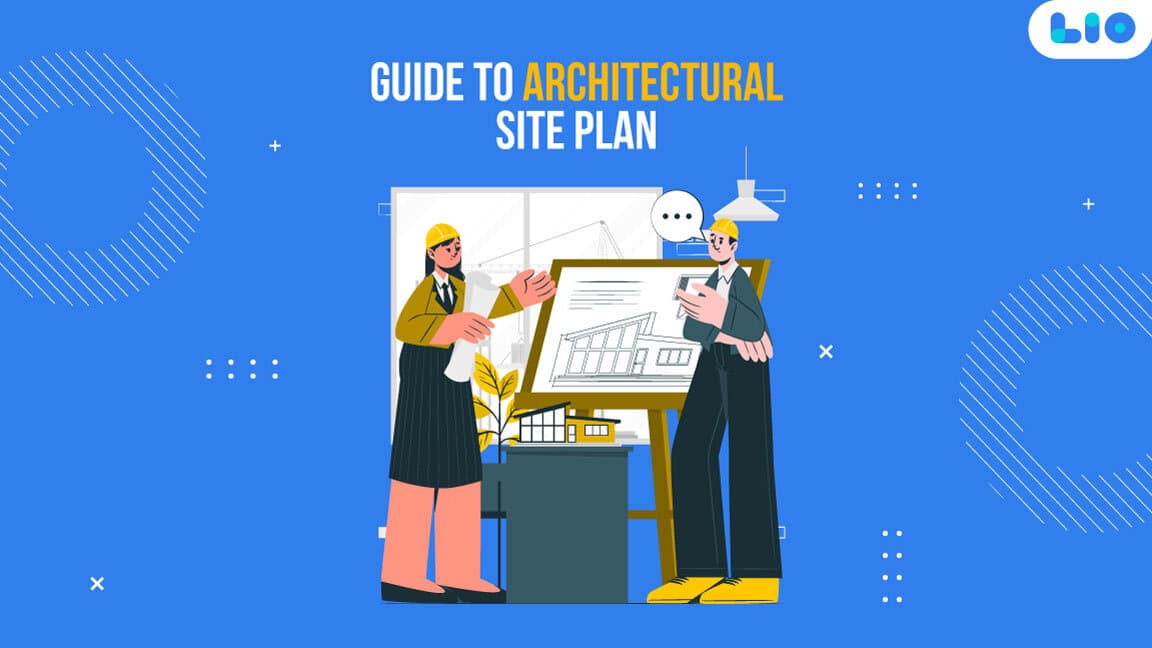
- The Ultimate Guide to Architectural Site Plan 2023

- All About Architecture Firms – The Best in India 2023
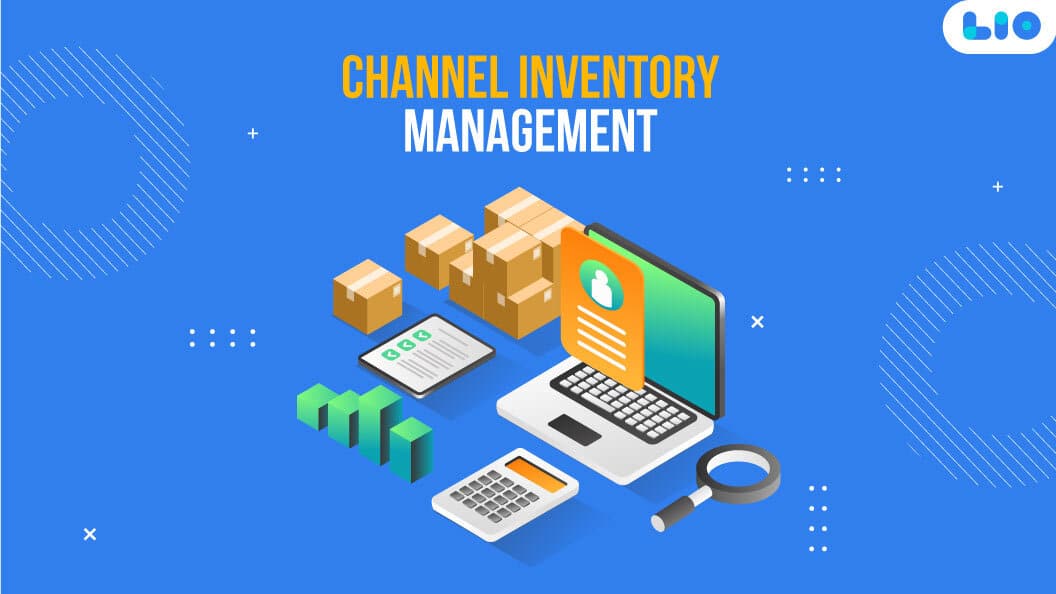
- Channel Inventory Management: Optimizing Stock Across Multiple Sales Channels

- 11 Awesome Applications for Architects and Designers
How to Start Electronic Shop Business In India
Surabhi Guleria
- May 24, 2023
- 10 Min Read

Interested in knowing how to start your own electronic shop business in India? We bring you a detailed and easy guide that will help you understand the process.
From fans to AC, oven to the fridge, lights to vents, phones to television and laptops and wristwatches, we are surrounded by electronics. Gadgets have made our life super easy as it simplifies the work and delivers instant outputs.
With the increase in demand for electronics, it has become one of the best business ideas in India . So let’s straight jump into the steps for starting an electronic shop business.
How to Start Electronic Shop Business in India
Starting an industry in electronics can be very challenging as this industry is volatile and can be difficult for startups if they lack a good blueprint to compete with many other established names in the business.
Hence starting an electronic shop business is a safe option and a profitable one. If everything is planned well in advance and one understands the business thoroughly then you can have a successful business. So here’s how to go about starting a business and opening an electronic shop business of your own.
Here are the steps to start an electronics store:
Investigate The Competitors
The first rule of all businesses is to investigate the competitors. Know all about them, what they are doing, their products, services, growths, success rate, failures, and marketing strategy.
There is a great deal that you can learn from it, things you should do and things that you should not. Knowing your competitor’s business module well will help you bring originality and uniqueness to your store that will set you apart.
Store Location
Location plays a key role in the success of your store. The location needs to have proper accessibility which will also improve the survival of the business.
Create, Share, Collaborate
Work with your team in real-time. create documents together and share the same on Whatsapp, Gmail, etc.
FREE OF COST
The location should convince the franchise to tie up with you which will give a lot of visibility to your store and eventually help in the growth of your business.
Set Up An Office Space
Set up a nice office space that will attract your customers and mainly the franchise companies when starting your electronic shop business. Having a nice base would show the seriousness of your business.
This gives psychological satisfaction to the customers of the displayed products and also gives a nice plush experience to them. This would also give the real feel of the product and make them realize what they really feel about it.

Doing Research About Franchise
Do deep research on the franchise electronics companies and the know-how they function this way you would be able to determine which of these franchises fits your budget, personal interest, and goals.
Know all the parameters and check beforehand if you qualify for the requirements. Once done, get an appointment with them to discuss everything related to the franchise.
Available in 10+ Languages
Hindi, English, Bangla, Urdu, Malayalam, etc. Now Work Comfortably in Your native language.
Raise capital.
All business heavily relies on the investment and the capital it raises. The capital needed in the initial days is a lot hence it is important that you start raising funds from early on. As per a survey, 57% of small businesses depend on personal savings initially.
You need funds for things like store inventory, location, products, lease amount, store fixtures, employee wages, marketing, etc.
Register Your Business
Registering your business is mandatory and there is no other way around it. Registering your business gives it a legal existence and also registers the name in the particular industry.
The government will identify your business only after you register it through the official agencies. This would also help you with a simplified taxation process as well as help in running your business smoothly.
Hiring Employees In An Electronics Store
You must hire employees to run a smooth electronic shop business. The people you need to hire are for the following positions:
- Floor Manager
- Supervisors
- Promotional Head
- Stock Manager
- Sales Representatives
Other departmental duties include-
- Maintenance

Business Insurance For An Electronics Store In India
Nothing in life is predictable. Accidents can happen to anyone whether big or small hence insurance is important that can cover all the damages. The insurances are an altogether separate wing with different types. Some common insurance policies that are offered for an electronic shop business are-
- Electronics store Crime insurance
- Electronics store Cyber liability insurance
- Electronics store Worker’s compensation
- Electronics store commercial auto insurance
- Electronics store business property insurance
- Electronics store general liability insurance
You can get them from private companies or government agencies.

Business License & Application Requirements For An Electronic Shop Business
A license gives a legal authorization on every product you sell, the exceptions being:
- If your store’s display space is less than 20% of the total display space, a license won’t be required.
- If you’ve less than 30 electronics for display or sale, a license is not needed.
Mandatory requirements for the application include-
- Sales Tax Identification Number
- For only electronics services- Electronic and Home Appliance Service Dealer License (2 years validity)
- License Number
- For selling second-hand electronics- Second Hand Dealer General License (2 years validity)
Since the electronics business falls in the category of retail businesses, you would have to obtain a state license for the same. So why do we need a license? Licenses act as a legal document or authorization that all businesses and the products you sell. Not all business requires licenses but you definitely need the following conditions:

- If you have less than 30 electronic goods for sale or display, then you do not need a license.
- Measuring in linear feet, if the display space of the store is less than 20% of the total display space, there is no requirement for a license.
Requirements for the application
To get an electronics store license, the following documents or legal identities will be required.
- License application
Again, there are two more subdivisions in the licensing part. If your plan is to offer service for the electronic good, you would need an electronic and home appliance service dealer license.
If you are selling second-hand electronics goods, you would need a second-hand dealer general license. These licenses have a validity period of 2 years post which you would need to renew them to continue the business operations.
Your Data Is Safe As A House
With daily backups, we ensure your data is safe and secure whether you lose your phone or it breaks down.
Online application process.
Three things that are required for the final stage of getting an EIN (Employer Identification Number)-
- Online Application
- Eligibility check
Make sure all the necessary documents are with you before you apply and this is a very important step as it might cause rejection during the process if you pause or take too long to fill in the form.
The check covers TIN, the location of the business, and other conditions pertaining to ownership and limitations of EIN applications. It is a single-session application process where resuming back to the webpage is impossible.
Once you submit, the verification process is initiated. Verification is done with the TIN you provide and the advantage of an online application is that you get the work done immediately. You get your EIN after verification and all you have to do is print it with the downloaded copy.
Also Read: Business Ideas in Mumbai

Maximize Your Online Business Potential for just ₹79/month on Lio. Annual plans start at just ₹799 .
How Can Lio Help In Starting An Electronic Shop Business?
Lio is a data organization app that not only arranges your data as per your preferences but also makes them available over the phone and to various users.
When an entrepreneur would first start their electronic shop business, they will just have a few workers, which means everyone will be working beyond their potential.
The business owner may keep track of time using Lio’s timesheets. Utilizing an app like Lio that can record employee timesheets would benefit not only employees but also management staff.
Lio also enables members and workers of a company to access a variety of data, services, systems, and other resources without having to look for them on a storage device or in multiple cloud storage places.
They have real-time access to and can analyze the data being collected. Any employee may immediately review the data they are keeping in the centralized repository.
Step 1: Select the Language you want to work on. Lio on Android

Step 2: Create your account using your Phone Number or Email Id.

Verify the OTP and you are good to go.
Step 3 : Select a template in which you want to add your data.

Add your Data with our Free Cloud Storage.
Step 4: All Done? Share and Collaborate with your contacts.

Yes, the competition in this field is a lot but if you decide on opening a franchise electronics shop, it is going to be a much better decision that would ultimately lead to good growth and a lot of success.
Studies have already revealed that the success rate of franchise businesses is 95% compared to the success rate of startups, which is 15%.
Hence starting your own electronic shop business would be a much better idea if done properly and if you follow all the above-mentioned instructions.
F requently Asked Questions (FAQs)
How much does it cost to open an electronics store in india.
It all depends on the location. In a big city, it can cost anywhere around INR 10 Lakh and above. In a small town, it can cost around INR 1 lakh.
Can the electronic shop business be profitable?
Yes, they are pretty profitable as there is an advancement in the technological upgrades and electronics sector.
How do I start a small electronic business?
The basic steps to be taken are:
Analyse your Existing electronic businesses Raise funds, find proper investors or get a loan Curate a solid & competitive business plan Know all requirements of electronics suppliers
How much is the margin in electronics?
Depending upon the type of products, for example on an average mobile phone you can earn up to 5-7% of margins.
How can I get an electronics dealership in India?
These are the ways through which you can get a dealership in India:
Before signing the wholesalers, do a quality check. Buy a bulk wholesale list. Enrol on local trade shows. Use powerful engines like Google Obtain Bulk Orders from companies exiting the industry. Utilise Yellow Pages. Buy from Big International Companies.
What is the importance of a franchise disclosure document?
This document is important as it contains important details all related to the franchise and how it functions. It is important that the store owner reads and gets aligned with all the details.

Benefits of Attendance Tracking System in Businesses
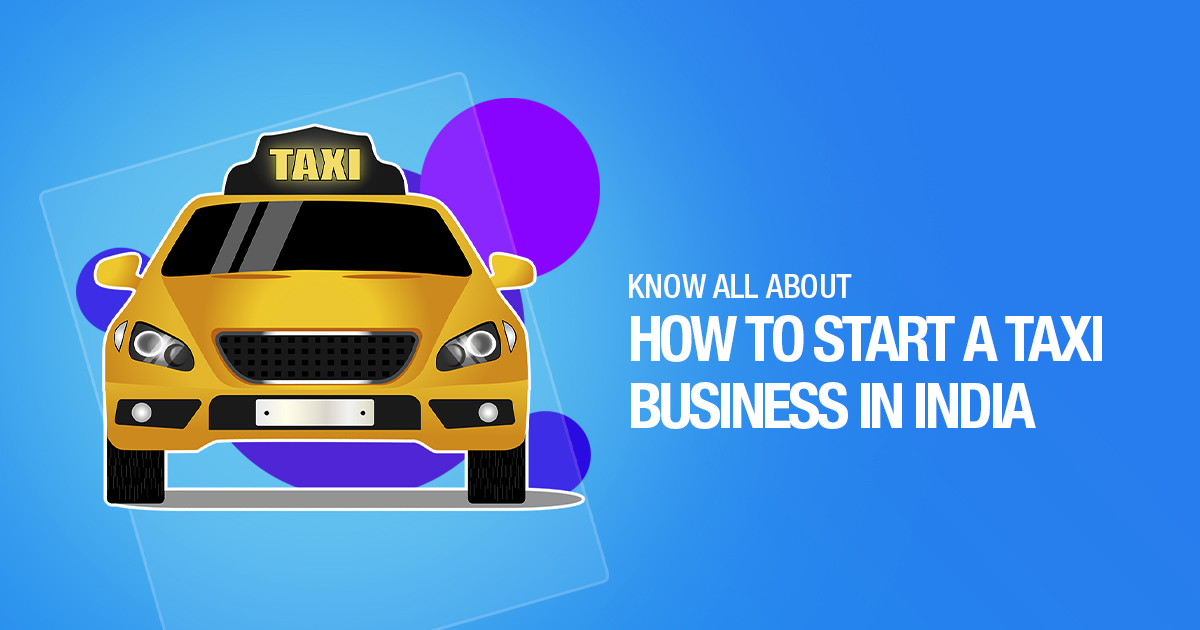
Know All About How To Start A Taxi Business In India
I’ve always wanted to launch my own company. I now have a very clear vision after reading this article. Thank you so much. Please write more about related topics.
Hello Diana,
The lovely words are greatly appreciated. I am delighted that my post piqued your interest and aided you in launching your firm. I’ll write more about related subjects for sure.
Best of wishes for your success in this new endeavor.
Please list a few benefits of a retail partnership. Please keep it short and simple.
Hello Indira,
Retail partnerships have a number of benefits, including empowering your customers, expanding your customer base and luring new ones, utilizing customer evaluations, boosting sales and conversion rates, and providing better data.
Would you kindly provide me with some simple info on how to calculate average sales in the right manner?
Hello Jitendra,
The total sales for the time you want to study and the period you want to use to calculate your average sales are two different things. Average sales can be calculated on a variety of time scales, including daily, weekly, monthly, and even annual basis.
You may easily get the total amount of all sales orders inside the selected timeframe and divide by the intervals to determine the average sales for your chosen period.
Can you please give me some advice on starting a mobile shop? I won’t be able to start a store selling electronics, but perhaps very soon. But with my mobile shop, I’m confident. Please assist if you don’t mind. Thanks in advance.
Hello Madhupal,
Without a doubt, one of the best small business ideas to start in India is a mobile shop. A well-run Mobile Shop earns an average net profit of 20% on daily sales. Make sure you build a solid business plan that includes all of the details on how to start a mobile shop . Best wishes for your new venture!
Leave a Reply Cancel reply
Your email address will not be published. Required fields are marked *
Save my name, email, and website in this browser for the next time I comment.
- Business Automation
- Business Guides
- Business Ideas
- Inventory Management
- Marketing Guides
- Software/App For Businesses
- Tips & Tricks
- हिंदी मे सीखे
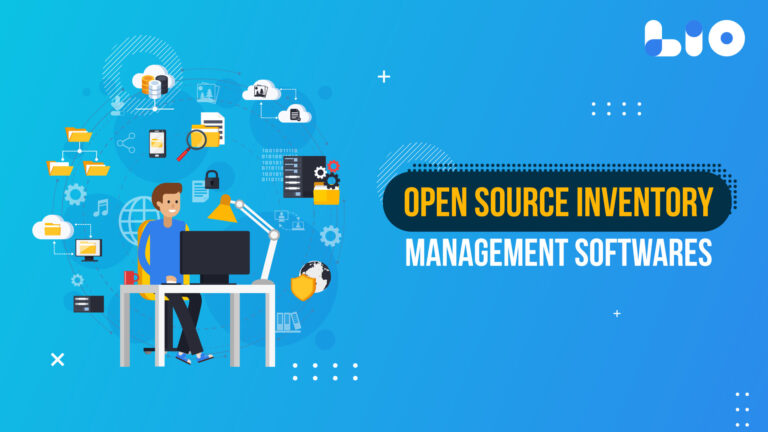
Top 10 Open Source Inventory Management Software: A Comprehensive Guide
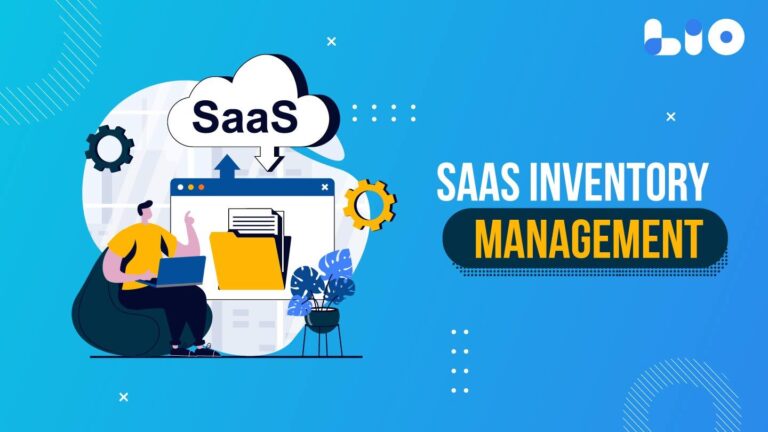
The Power of SaaS Inventory Management: Streamlining Your Business Operations
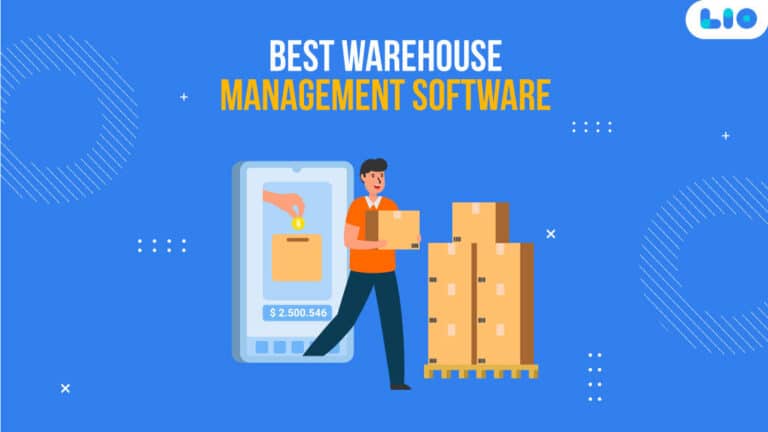
Streamline Your Operations with the Best Warehouse Management Software
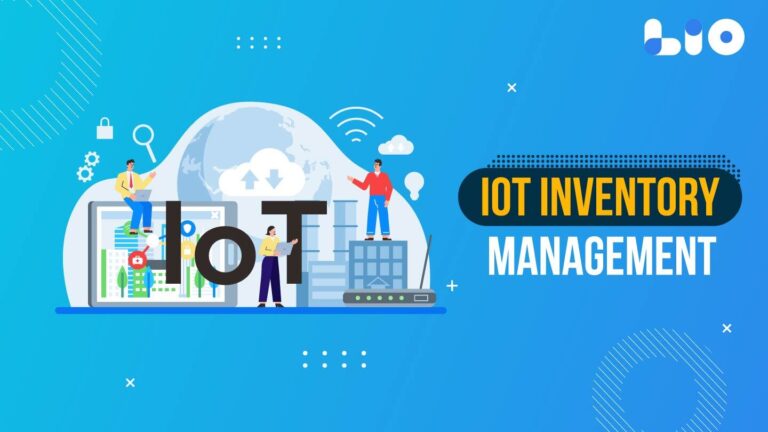
Harnessing the Power of IoT: Revolutionizing Inventory Management
Related posts.

6 Steps – How to Start a Real Estate Business in India
Wondering how to start a real estate business in India of your own? Look

How to Sell on BigBasket – Know All About It
Wondering how to sell on bigbasket and how to go about the whole procedure?

How To Start A Cafe In India
A freshly brewed coffee is the best thing when one is confused or exhausted.
Join the Lio Tribe
Receive a dose of inspiration and innovation in your inbox..

A Complete Guide on How to Start an eCommerce business in India

Parnas Ghosh , Abhinav kumar
If you are looking to start your own e-commerce business in India like Amazon or Flipkart, then this is the way to go. To start with, eCommerce is an online process of buying or selling goods and services. There is no paperwork involved in making any transaction here.
One of the best things that most of us like about an e-commerce startup is that we can update and modify it the way we want and make it attractive and appealing to the eyes of the audience. Your customer will have access to your services 24x7 and you don’t need to come out of your door for marketing and other stuff if you are doing it at a small level.
According to a report, in 2019, eCommerce sales accounted for 14.1% of all retail sales worldwide. However, there are some things that you need to care about in your eCommerce business plan .
How to Start an eCommerce Business in India? (A 10-Step Business Plan)
How to build an ecommerce startup, how to compete in the ecommerce market, how do ecommerce sites make money.
Starting an eCommerce website might sound challenging, but with this easy 10-step business plan, it would hardly be tough. So, let's dive into the steps:
Step 1: Define your business name
Business names are always important as they give you an identity after identifying what you want to sell. A business name will be the legal identity of your business. This opens a room for marketing your product with ease. The name that you choose should be simple and unique. It is always better to research extensively before you decide upon a particular name for your business. This will let you be safe and secure, and thus, is really important for everyone who would be starting an eCommerce website.
Step 2: Set a domain name
Ideally, there is always diversity in business. The business name acts as the domain name . A domain name system (DNS) stipulates the website address that your business wants to keep.
One of the important factors for an eCommerce business plan is a website. A website can be useful in developing different marketing strategies. It acts as a point of contact between you and your customers .
A website is accessible to many people at any given time and creates a climate of trust (credibility). Churning out a website is really convenient as it tells the customers that you exist. Furthermore, the website and the domain name are some of the core steps to proceed with before one can go about launching an eCommerce business.
Step 3: Identify the type of business and register
People engage with businesses as sole proprietorships, partnerships, or cooperation. Each of these has an advantage and disadvantage attached to it. For example, operating as a sole proprietor always subjects you to numerous risks.
You need to weigh before deciding upon a particular type of business that suits you. The income removal system (IRS) allows you to file the structure of your business on your own or get a different filing company to help you.
Step 4: Employer Identification Number (EIN)
You can not operate an e-commerce business without a bank account. To get a bank account you need for your business you need EIN . This number you are given acts as identification. You use it to file taxes for the business . It is always a requirement whether you will operate alone or employ people.
Step 5: Obtain legal documents
Every country has its own policies and procedures that every citizen must adhere to. This is also one of the things you must keep as a priority while creating an eCommerce business plan. If you fail to do that, the government has the mandate to declare your business illegal, after which numerous penalties might be imposed.
Licenses for the business and work permit should be obtained. Confirm with your state what type of taxes you are required to pay in order to operate. Also, you need to Apply for Goods and Service Tax (GST) certification and a Shops and Establishment Licence.
Step 6: Source for vendors
It is not possible to operate without vendors . Everyone needs to identify and keep in contact with different vendors. This way you can derive the best quality and prices for the materials you need to make your products. Conduct a thorough and serious search of the vendors to help you identify who you want to work with.
Step 7: Early marketing
Media platforms are paramount in e-commerce. However, it is also necessary that you have an eCommerce business plan prior to that. Alert customers that there is something good coming up so they can create interest to know. You can even decide to introduce blogging as a tool .
Step 8: Get effective software
E-commerce cannot work without making use of technology. Put every system in place before launching the product. Effective software is what you simply cannot compromise when it comes to building e-commerce websites in India.
Step 9: Keep a smart inventory
Inventory will help you track the information that you need. Ensure the warehouse (store) has enough products so that the customers don’t miss out on what they want. You may not be in a position to tell what will be needed and when but is always safe to keep a decent stock. This will help keep track of the orders you make in the future.
Step 10: Be compliant
Always be smart with deadlines in terms of taxes, licenses and permits needed. Always ensure you abide by the law of the land. Staying compliant is the key to starting an eCommerce store or an online business and making it successful.
The Ecommerce industry is on the boom for the past few years, and why not? It is ultimately a sector with big opportunities and low barriers to entry. The total valuation of the e-commerce industry in India was last recorded at $46.2 million and is expected to rise to $188 billion by 2025 . Such a sector that is ever so growing, certainly consists of a lot of opportunities.

Currently, there are hundreds of e-commerce sites selling products and services and thousands are on the way. Probably you also want to have one. Well, the e-commerce industry is so dynamic now, that you need to be agile and alert. So, keep monitoring the activities, events, discussions, and changes going on in your niche.
Now e-commerce is not about selling a product but a solution. Your potential customer must see the clear benefit of buying from you. Here are some tips to follow if you are starting up or already have an existing startup in the e-commerce domain.
Find a niche
If you get an idea for e-commerce, there is a fair chance that many startups are operating in that niche and many are coming up. That is why it is important to break the initial idea, segment them a little further or get a niche that is not explored yet and work on that with full focus.
If you think you can compete against Flipkart or Snapdeal that's not going to happen if you plan to start with the same business model .
Take sandal. When the company launched, it was an online portal for deals and coupons. This was a very focused play. They didn’t immediately start selling physical goods. Make your unique selling proposition, find your target "janta" or customers, and sell your product to them.
As you have started out, the world seems very new to you. Nobody except you can tell what works best for you. So, experiment with different Pitches , Distribution channels, and more. Do this until you find out a solid sales strategy .
Listen to your customer
As it is always said worship customers like gods. Always remember that if there is any service you want to provide, then that should always be a customer satisfaction service . Your behaviour towards the customer after the sale would make all the difference.
This will help you in customer retention and thus make more sales. Once a sale is made. Talk to them, get feedback and see what changes they want. Even if it doesn’t comply with want you want just change it.
Learn from the mistakes of competitors
Do you have lots of competitors? Having too many competitor s is not so good news for businesses but every bad thing has got something good in it. So, if you have quite some competitors already in the same space where you would be starting your own eCommerce business, you can try to analyze their website design , pricing, and marketing strategies on a regular basis to get useful insights for future action. Go through their social media profile to see what activities have helped them gain traction a lot and what has failed for them. In this way, pick up all that they have done good, and try to avoid all the mistakes that they have done.
Use digital marketing
74% of adults who are online, use social networking sites, and among them, it has been found that 71% of online adults use Facebook. Being a startup you don’t have much marketing budget. Here, starting with social media platforms for marketing purposes will indeed be of great help. Optimising the content and regularly sharing them on social platforms certainly is rewarding for brands and businesses. This will not only let you reach to large audience economically but also help you to get analytics to learn about the users. It is also a great way to listen to what customers are saying about your brand.

Make sure you always have enough inventory of the highest-selling product. Make sure that you keep a track of all the products that belong to the highest-selling and lowest-selling categories. Figure out what is making the highest product sell the highest and what makes the others the lowest-selling products. This will help you a great deal!
Choose the right web hosting
Looking at what similar companies are using. Add a mascot on the site that guides the users about the site and the products, is an interesting way to get the attention of customers (like Zendesk). Use only those plugins that are necessary.

Consumer support
Hire trained customer care executives to resolve customer queries over calls and emails. A toll-free number and support email is crucial too. Solve the problems that the customer is facing, to ensure the efficiency of the website.
Content marketing
The content is important for an e-commerce website and is good for marketing the brand. Putting up a blog or posts will surely bring up more traffic than ever. Content marketing will stand as one of the primary requisites as soon as you start an eCommerce store or an eCommerce website in India.
Social Media Marketing
Social media is the key to climbing the ladder and getting the exposure one wants in the public eye, so creating social media accounts is the key to helping the brand reach the eyes of the world. Keep the followers updated with new products and give ways to get more followers. Meme marketing is also a great way to engage your customers (Millennials).
Influencer's utilization
The influencers are the best people in the game especially, in terms of product branding and making the future of a product. Hence, hire some influencers who are the best in the marketing game , which your brand focuses on, and pay them to put the ad on their social media. This will help increase your brand reach, thereby helping it to reach thousands and millions, who would then be able to see what your brand and its products are all about and people will pop up on the website for sure, giving you more website traffic and multiplying your revenues for sure.
Every day is new and brings changes in people’s needs and desires. Luckily, this is where small and upcoming startups can still win in the midst of other eCommerce giants. Here, is how to compete in the E-commerce market.
We are aware of how Amazon and eBay have driven many small and medium companies to extinction. But the other side of the reality is also that new interventions are always abundant and there's always a new idea, product concept, or methodology that can topple the market leaders as we know them, or at least create a comfortably sweet spot in the market for themselves-which is just where your startup needs to reach.
If your startup is introducing a new product or service altogether, there is a very different approach you might need to take as compared to a start-up that is re-offering the existing product or service to bridge the demand-supply gap.
Be very clear as to who you are, what your offer is, and what your target is. Make sure that your core team and your entire organization have this understanding to ensure that the combined effort of the entire workforce maximizes the results.
It is a hopeful time to be as Amazon and the likes do cater everything to everyone. But the digital age has made it possible for everyone to co-exist as people’s tastes are ever-evolving and start-ups targeting the niche will be able to carve out their own space.
Read on for sage advice on how you can stand out in a crowded marketplace and reap the maximum benefit of being a newcomer to the industry.
Create Your Own Service
Your chance to be victorious in the game is to be an innovator and make your own market rather than depending on the existing marketplace. It is a harder approach to what you are already doing but will take you miles ahead of others.
See a Need, Fill a Need
We have seen time and again that certain brands launch big after years of testing and planning, however, once the brand is not received well they start to fizzle out. The ones who make it successfully are often seen using the feedback from the customers and dedicating some resources to perfecting common complaints and difficulties consumers are experiencing. They don’t quit, rather, they use real-time data as the major source of what the next step is inspired.
In fact, building on what the customer conveyed as your shortcoming can also forge a trustworthy and loyal bond with them, which is a great way to market yourself. Instead of resisting the feedback, be open to them and make your way to their hearts by listening and acting on it. Create your own trend rather than following the norm.
Champion the Mobile App
Make sure that your customer is having a seamless mobile experience on your app and is likely to check out under 60 seconds after preparing the cart or choosing the service without any in-built interruptions. Fast times require faster solutions! In addition, make sure your startup belongs on platforms like Snapchat and Instagram that have made the visual world fun and directly accessible.

User-Centric Approach
Design Thinking promotes that design is an elementary part of any system. Design your product, service, or systems within the organization always prioritizing the user needs and user practices.
Get inside not just the mind of the end-user, but also their daily lifestyle, their influences, their dreams and aspirations, their environment, and their culture, depending on the nature of your services.
Customer is more likely to trust your brand if they think you thought of them specifically while making the product or service. This gives them confidence that you will understand them and will stand as a good choice for them.
Better Incentive Programs
Your incentives can come in the form of discounts, rebates, points earned toward a discount, points earned toward prizes, or any of many other plans. The worst-designed incentive plans have ambiguity in the stated rules.
An incentive is likely to shape your customer’s behaviour and drive them to your desired action. These incentives are thus, really valuable for an eCommerce company, especially if you are wanting to start an online store in India. If they are rewarded for their purchase, they feel like they ‘earned’ it. Keep a close eye on what other e-commerce companies in India are offering and if you are to compete with them, you must outdo their offer every time.
Better Customer Service
A common Amazon trait that has made it wildly popular in the e-commerce service is how they value each customer. Similarly, if you also want to start an eCommerce business, then you must first start to value each and every customer the same. While you can’t crush e-commerce giants given that they have bigger marketing budgets and bigger control of their product lines, operations and sales, it is certainly a trait you can imbibe in your company. Each satisfied customer means five people who will hear about you from him, which is great marketing for you at no actual cost.
Customer Data Is The Key to Ultimate Business Growth
A former Amazon company worker stated that Amazon has the ability to track both what people are buying as well as what they search for and can’t find.
This is a part of their success story. Companies that use customer data to better their practices are more likely to increase their sales and their gross margins than those who ignore the data.
Even if you don’t have big budgets to acquire data like e-com giants, do make absolute use of the behavioural data you already have in their database to improve customer satisfaction and customer retention.
Everyone wants an extra income to meet their needs and upkeep their standard of living. Furthermore, buying and selling goods and services via the Internet is the new trend to earn money, and the websites that make them possible are none other than Ecommerce websites. The Ecommerce websites are offering a free platform for the sellers and the buyers to get in touch with each other.
One can easily list their products on e-commerce websites and potential buyers can buy the products hassle-free sitting in any part of the world. The whole online buying and selling chain appears to be a very easy and economical process.
Although, you must have wondered as they offer free services to sellers and buyers then how these e-commerce websites like OLX , Quikr , Craigslist , and Gumtree make money online.
E-commerce websites, such as OLX, Quikr, and other leading sites provide an online portal to advertise your product or service offerings and find the buyer for them.
Almost all emerging e-commerce websites offer free services to users. However, they still make high-tech TV commercials and disburse lucrative salaries to their employees. How? So, let’s get the answer by analyzing the revenue-generating strategies of a few leading e-commerce websites and comparing their revenue plan with others.
OLX is one of the most popular and well-structured e-commerce websites. It offers a variety of features to its users, such as sellers can directly chat with a buyer, can easily bargain, etc. eBay is one of its competitors of OLX. OLX opts for the following methods to earn money:
Google AdSense Banner Ads
Google offers to all bloggers and website owners a very easy platform to get advertisements on their sites. Google AdSense is a platform where you can register your website and after verification, Google will show related advertisements. Hence, OLX effectively runs Google ads to reach its target audience. The earnings through ads depend, upon the number of clicks they get which is called CPC (cost per click model).
Featured Listing
OLX offers a featured listing option to the sellers. Featured links are those links that you see on the top, whereas, in a normal listing Ads are placed in OLX depending on how recently the Ad has been placed.
Featured Ads will always appear on top of the list irrespective of any factors. Ideally all such should be mentioned as featured/sponsored/ads so that users don’t get an illusion. In a featured listing, your ad will show up at the top of the search list and your ad will be shown first to the buyers whenever they search for anything on OLX. The sponsored links appear depending on the keywords targeted by the advertisers. Being at the top of the list gives advertisers a way to get more leads.
Quikr is yet another e-commerce, which is very popular in India and somehow looks and works similarly to OLX. While the featured listing is one way to make money Quikr also follows a different route here.
They also generate revenue by generating leads for businesses. It makes a gainful amount of money for Quikr. Recently Quikr has acquired a few startups to diversify in different fields like Jobs, spas, and salons where they provide leads to these service providers.
Craigslist is also a popular rental listing website. It is mainly popular in the USA. But the company doesn’t earn as much revenue when compared to other websites. The company only makes revenue equal to its operation charges.
It charges $10 for a rental listing in New York and $25 for a job listing to occur in any of the major U.S. cities. If in the San Francisco area, you need to pay a $75 fee for a job to be listed.
The company is trying to consider Google AdSense and paid advertisements to generate more revenue, but it is still worried about the quality and clutter on the website due to ads, which is the main priority of the company.

Other eCommerce Websites
There are other similar eCommerce websites present, like Gumtree and BookSellBuy. They also earn through a basic business model, that is, by providing premium membership Ads wherein the features depend on their own model, by featured ads and paid listings. So, almost every website uses paid ads to generate money.
Now, building an eCommerce website is the trend. It definitely takes a lot of effort and hard work, but once created and branded properly, it will surely open a whole lot of doors for growth. It is not an easy task to run an e-commerce business in India in the current age of competition. Starting an eCommerce company or an eCommerce business in India is certainly achievable if one has the focus and grit to understand the customer and the people who are in the organization.
Use your data efficiently and always make the customers happy at the end of each transaction. Comment on your favourite e-commerce site or your story of launching your own e-commerce site in the comment down below .
What are the 3 types of e-commerce?
The three types of Ecommerce are Business-to-Business (B2B), Business-to-Consumer (B2C), and Mobile Commerce (M-Commerce).
What is the future of e-commerce?
The eCommerce industry was last valued at $46.2 bn in 2020 and is expected to rise to $188 billion by 2025, and would soar to become $350 billion by 2030.
Which is the largest e-commerce company in the world?
Amazon is the largest e-commerce company in the world.
How much does it cost to start an e-commerce business in India?
To start an e-commerce business in India you need approximately at least 5 - 10 lacs of investment.
How to start an eCommerce website, store, or eCommerce business?
Whether you want to start an eCommerce store/site or an eCommerce business, it is evident that you first need to research the industry and the market potential before starting up. Starting an eCommerce company in India would need you to:
- Build a fast, comprehensive, and informative website
- Create a viable business and revenue model
- Decide a relevant domain name
- Host the website properly
- Market your website, its products, and services
- Monitor the performance
What are some of the eCommerce business ideas?
Some of the best ideas if you want to create an eCommerce website or an eCommerce business in India would include grocery delivery, cosmetic and beauty products eCommerce business, refurbished or second-hand products business, fashion, jewellery, food tech and more.
What are some things that you should never forget while trying to set up an eCommerce business in India?
Setting up an eCommerce business in India is the dream of many, but only some eCommerce businesses in India actually see the light of day. Here are some of the easiest steps that you need to remember while setting up an eCommerce company in India:
- Chalking out a workable business and revenue model
- Branding your brand well
- Registering the business
- Opening a bank account and linking the business to the same
- Creating and launching a simple but secure eCommerce website
- Installing payment gateways
- Monitoring and improving the logistics
Must have tools for startups - Recommended by StartupTalky
- Convert Visitors into Leads- SeizeLead
- Payment Gateway- Razorpay
- Spy on your Competitors- Adspyder
- Manage your business smoothly- Google Workspace
A Look at Berkshire Hathaway's Marketing Strategy
Berkshire Hathaway Inc. is a highly diversified American multinational conglomerate holding company headquartered in Omaha, Nebraska, United States. The company has a rich history, dating back to 1839 when it was established as a textile manufacturer. However, under the visionary leadership of Chairman and CEO Warren Buffett and Vice Chairman
Swiggy - How is it Delivering Happiness at the Doorstep?
Do you wish to have a delicious bite of blueberry cheesecake in the middle of the day at work or a hearty biryani meal for lunch? Moving out of your house, facing the relentless traffic, unending queues at the restaurants and cafes, waiting for your order, etc., sounds demotivating as
Biigbull Financial Services Private Limited Makes Financial Security a Reality for Everyday People
Jamshedpur (Jharkhand) [India], April 10: Imagine a world where financial literacy and investment opportunities are no longer reserved for the privileged few. This is the vision that drives Biigbull Financial Services Private Limited, a company built on the remarkable story of its founder, Mr. Raj Kumar Paswan, and his unwavering
Plant-Based Protein Gaining Traction in India
Vegetarian and vegan alternatives have increased in Indian restaurants since the new year started. The recent introduction of vegan burger patties and nuggets by ITC demonstrates the growth of this sector. Various forms of food production may now give greater consideration to vegan options. As per the analysis by CNBC,
How to Make an Ecommerce Business Plan for Your Startup
Darren DeMatas
February 28, 2024
[show_reviewed_by_link]
In addition to receiving commissions generated through affiliate marketing, we are able to fund our independent research and reviews at no extra cost to our readers. Learn more.
So you’ve decided that you want to quit your day job and start your very own ecommerce empire. That’s great!
But before you become the next Jeff Bezos (and definitely before you quit your job!), it’s worth spending some time thinking about a business plan. In this article, we’ll dive into the key elements of an ecommerce business plan, which is very different than writing traditional business plans.
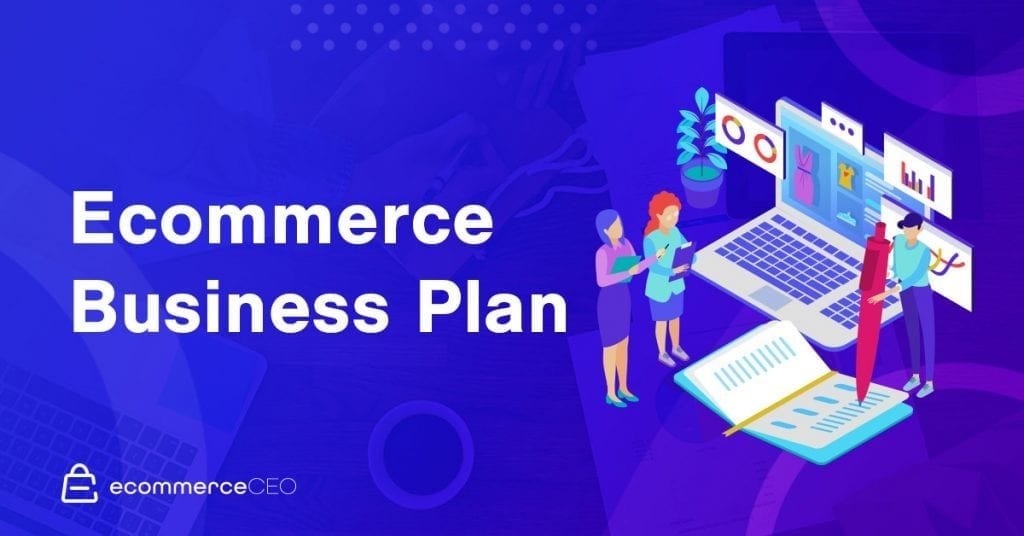
Why You Should Create a Business Plan
We know that starting an ecommerce business is exciting, and it can be tempting to jump right in without constructing a business plan. READ: PLEASE DON’T DO THIS.
If you haven’t put your ideas, questions and concerns on paper, then you haven’t given your business model enough thought .
Taking the time to write a business plan might seem like a lot of work, but it can save you a lot of time and money in the long run by better preparing you for potential challenges and opportunities that you’ll face as a first-time entrepreneur. Think of it as a roadmap for your new business venture.
It’s exciting to start your own ecommerce business. However, you want to be well prepared and not jump into anything without having a solid, foolproof ecommerce business plan in place.
After all, you wouldn’t jump out of a plane without a parachute, so why start a business without a safety device in place? That safety device is your business plan.
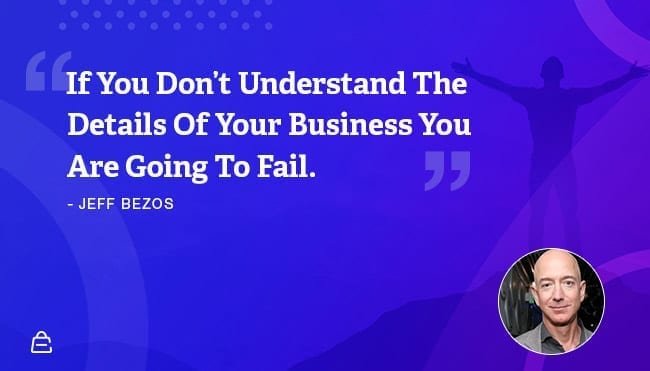
The business plan is the brainstorming process that ensures your concept and goals are realistic.
This is more than just mental notes. True business plans take your ideas , questions, and concerns and put those in writing.
As you start creating your business plan, you’ll soon understand that it’s more than a single piece of paper with handwritten details on it. It’s a clearly constructed format of how your business will be created, how it will operate, and what you hope the future holds in terms of a successful ecommerce business.
When you write your business plan, be sure to have a target audience in mind. Are you going to look for investors or put a Kickstarter campaign into motion and use this as your descriptive platform? If so, make sure that your business plan contains everything the audience would want to know about your business (and more!). Many traditional funding solutions require a business plan in order to give you capital. However, there are alternative solutions, such as Payability that specialize in ecommerce and don’t require credit checks, a business plan, or any complicated paperwork. They can also get you approved in as little as 24 hours.
When your business plan is completed, you should have achieved the following goals:
- Knowledge: A greater sense of knowledge of the business aspects.
- Resources: The resources you’re going to need to make your business successful, such as partners, money, employees, etc.
- Road Map: Have clear set goals to take you from the very beginning of your business and onward.
- Viability: In other words, is your business possible? Will you have enough profit margins to keep the doors open long-term?
Now that you know why you should create a business plan, it’s time to move on to how you can create your business plan and get started putting your ecommerce business into motion.
How to Start an Ecommerce Business Plan
At the very beginning of the planning stages, it’s a good idea to develop a framework for your business model. This business model will continue to evolve as you create each section of your ecommerce business plan, so don’t strive for a perfect completed plan on the first try. You will be making tweaks to the plan of certain steps along the way.
There are many ways to sell products online and different business models to pursue. Research and learn from successful ecommerce business examples in the market. The exact business model you follow will be one that makes the most sense with your resources, skills, and interests.
In order to create the best online business plan with your product in mind, you need to figure out the following things:
What are you selling?
The first step to creating an online business is to learn the absolute basics of what you can sell.
- Physical products: Clothing , shoes, home goods
- Digital products: Software as a Service products, ecourses, ebooks
- Services: Consulting services, home cleaning
Who are you selling to?
- Business-to-Business (B2B): You are selling to organizations, corporations, and non-profits rather than individual customers
- Business to Consumer (B2C): This means you are selling to individual consumers rather than businesses
- Marketplace: You are acting as a middleman by bringing businesses and (B2B or B2C) customers to one website.
How are you sourcing your product?
- Manufacture in-house: You make your product or service in-house
- Third-party manufacturer: You outsource the manufacturing of your product or service to a third-party manufacturer
- Dropship: You partner with a dropship manufacturer. Basically, this means that they make your product, package it and ship it directly to your customer while your company handles the entire customer relationship.
- Wholesale : You buy goods or services from other companies in bulk and re-sell those products on your online store
Additional References
- Entrepreneurship: Business & Marketing Plans
- Small Business and Entrepreneurship
- Entrepreneurship Resources
- Business Plan Resources
Executive Summary

The executive summary will be written according to your goals, and it’s recommended that this is done at the very end of your business plan completion. This will ensure that you include all of the important factors about your business and present your ideas in a concise and complete way.
Some of the features you’ll include in the executive summary include information showing that you’ve done your research, you have concrete sales forecasts, and the main details about your brand.
Business Model
When you’re figuring out your business model, you have to consider four different areas:
- Monetization strategy
- Product/industry
- Target market
- Sales channel
Monetization Strategy
The monetization strategy delves into the methods you are going to use to sell your products.
This strategy will look at different product monetization methods, including white label, private label , affiliate marketing, wholesale, dropshipping, and even selling ads.
Product/Industry
The product industry section is where you summarize your main niche.
For example, “Vegan Skincare Products.”
Target Market
In the target market section, you will write a sentence or so on who your target market, or ideal customer, is in the community.
If you’re selling vegan skincare products, your target customers might be women who embrace the vegan lifestyle and use natural skincare products in their daily beauty regimen.
Sales Channel
The sales channel refers to where you’re going to sell your products.
For example, you might be selling your products on your own website, and this should be entered in this section.
Business Overview

This next section covers your company overview.
This section of your business plan will cover various features of your company, including the following:
- Company type
- Domain name
- Value proposition
- Brand traits
The brand name section lists your business name or brand name.
This is an extremely important aspect of your business plan as it’s what will set the tone for everything that follows.
Pick a brand name that’s simple yet unique and is something that can be used in a wordplay manner, if desired, but not pun-worthy.
Company Type
The company is how your business operates. For example, you might label your business as an LLC , S-corporation, sole proprietor, or some other type of business organization.
The best way to determine how you should categorize your company is to speak to your accountant. There are various tax and legal aspects to forming your business in a certain way.
Speak with the professionals in the company and corporation formation field to determine how to label your company and which company type best benefits your business in a variety of ways.
Domain Name
This section is where you list your domain name.
Choose a domain name that is memorable and embraces the overall traits and features of your business.
And, when choosing a domain name, be sure to think of SEO aspects when doing so. You’ll find out just how much all of these things tie together and ensure a frequently-visited website is the end result.
Keep in mind that with ecommerce, the domain name is just as important as the brand name. Maybe even more so!
Value Proposition
A value proposition is a short, crisp statement that will gauge how clear your idea is. Write this section as if you had one minute to explain your business to a potential investor or customer and then practice it over and over again.
The value proposition can be used on your ecommerce store as your company description.
Here’s a good example: Say you’re looking to start a hiking company called Atlas Hiking Co. which sells premium performance hiking shirts. A possible company description could be the following:
Atlas Hiking Co. is a lifestyle hiking company that produces high-performance hiking shirts for outdoor lovers. Our proprietary SPF40 fabric is one of the lightest fabrics on the market, providing mountain lovers with maximum comfort, both from a breathability and sun-protection standpoint. Our product is made in the U.S.A. and a portion of our profits are donated to preserve national parks around the country.
Pay special attention to all the sensory words !
The mission statement in your business plan is the “why” of it all.
For example, why you started the business, why you are selling the products you are selling, etc., can all be added to this section of your business plan.
You can make this portion as simple or detailed as you like. Just make sure to properly and clearly explain your business mission.
The vision part of the business plan is your “how” in the grand scheme of things. It is the dream you have for your company and the path you’re going to take to realize that dream.
When you write the vision portion of the business plan, think long-term. What are you hoping to achieve, not just in the near future but for the long haul of the life of your business?
Look into the future and plan out where you see your business in 5, 10, even 20 years from now.
This will help you construct the rest of your business plan if you know where you want your business to head, now and in the future.
Brand Traits
The brand traits section is a short section in your company overview.
Basically, in the brand traits section you’re going to want to list three to five words that describe your brand.
Think of your brand personality and describe it using a few separate powerful words.
The personnel section lists all individuals, including yourself, who will be involved in the daily operations of your business. You can create a separate section for a full operations plan or add that later.
Some business owners choose to handle all duties on their own or with a partner, while others will hire individuals to fill the following roles:
- CEO (usually the business owner)
- Management team
- Customer service/logistics
- PR/Social media specialist
- SEO manager
- Advertising manager
Competitive Market Analysis

Here’s a fact you can bank on: there has never been a successful e-commerce entrepreneur that didn’t understand his/her target market cold.
That’s why this section is one of the most important in the entire business plan. It will force you to understand the industry in which you operate, the overall industry analysis and outlook, the existing competition, and your target customer demographic.
Market Segment
The market segment portion of the business plan will help you to put your ideas down on paper, make them more focused, and get your team together.
This area will include your niche selection, target market, and competitive analysis.
Niche Selection
The niche section provides an overview of your niche, why you selected it, whether there’s a micro niche included, and the type of niche you’ve chosen.
The purpose of this section is to crystalize the ideas that you have and make sure they are understandable and viable.
The target market section covers an overview of your target market plus describes your market segments.
Ask yourself who your target customer is (population size, age, geography, education, ethnicity, income level) and consider whether consumers are comfortable with buying your product category online.
When listing the target market information, make sure to mention your target audience size as this is important for ensuring that your audience will be adequately covered.

Competitive Analysis
With the competitive analysis portion of your market analysis, you want to list your market leader and direct and indirect competitors.
After you mention who these entities are, you need to list the characteristics of each one, such as domain name, business model, monthly traffic, and pricing range.
However, before you even get started in writing this section, you need to spend several hours researching your target market.
Here are some of the most efficient ways to research a particular market:
Industry reports
Google is your best friend. Look for any recent industry reports on your market of choice. This will give you a good sense of how much growth the industry is experiencing, why this growth is happening, and what are the largest customer segments. In our example of Atlas Hiking Co., we should research the outdoor apparel market.
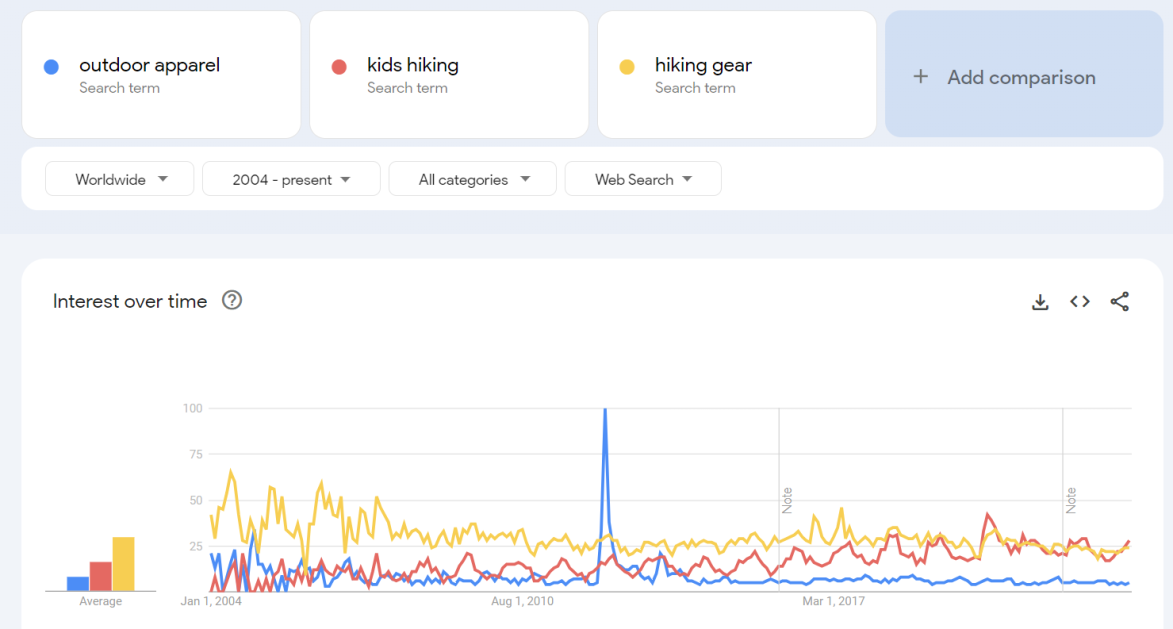
Let’s say that through our research of the outdoor apparel industry, we discovered that there was a huge boom in youth hiking apparel. Perhaps parents were increasingly concerned about their kids’ exposure to UV rays while hiking, so they began to spend more money on their kids. We could use this valuable information to guide our business strategy.
There’s only so much you can read online. Go to a nearby store that sells similar products to yours and interview the store representative. The store rep has interacted with hundreds of interested customers, which can lead to thousands of valuable insights! It’s amazing how these insights can translate into a meaningful business opportunity.
Here’s an example:
If I were going into Billy’s Outdoor Store to research the outdoor apparel market, I would probably ask Billy the following:
- What are your best-selling products?
- What are your worst-selling products?
- Find products similar to yours and ask the representative his/her favorite features on products similar to yours.
- How much are customers generally willing to spend on these types of products?
- Do customers make repeat orders of any of these products?
- Do you get a lot of customers that are looking to buy last-minute hiking gear before they go on a hike?
Competition
Create an Excel spreadsheet of all of your competitors. In your spreadsheet, you should have the following columns:
- Competitor Name
- Price point
- Product Description
- Key Features (e.g., fabric, waterproof, slim fit, etc.)
What is the competition missing? Is there a gap in the offering? Where you can add some additional value?
After conducting the competitor analysis, Atlas Hiking Co. might find that the competition’s hiking shirts offer very few features at a low price point, but no one offers a luxury hiking shirt with additional features at a higher price point.
This is just an example of the types of insights one can gain from market research which can drastically alter your business model.
Keyword Research
By using Google’s keyword planner and trends pages, you can get a good sense of how in demand your product is and whether it’s trending upward or downward. Google is great for a general idea, just don’t bank on it.
Some other keyword tools you can use for keyword research include Ahrefs, JungleScout, and Viral Launch. Check out this list for more ideas.
Trade shows
Are there nearby trade shows that you can go to? Again, creating connections with other people in your industry is a surefire shortcut to countless hours of reading on the internet. Trade shows are also a great opportunity to talk to competitors, meet manufacturers, and better understand where things are heading in your industry.
Once you finish researching the relevant industry, you should summarize your findings by answering the following questions:
General Industry
- How big is the overall industry?
- How big is the specific sub-industry in which you intend to operate?
- Where has most of the historic growth in the market come from?
- Why is this the right time to enter this market?
- What are the sub-segments that are poised for future growth (e.g., youth apparel)?
- How crowded is the product category with competition?
- How is your competition distributing its product (online, retail, wholesale, etc.)?
- What’s missing from the competition’s product offering?
Products and Offers

So we know we want to sell hiking shirts, but how do you research specific products?
But for some of us, we’re not quite sure what we should sell. To succeed in online retail, you need a product that is trending upwards in a growing niche.
Different types of products
Some of the different types of products include the following:
- Convenience products: Frequent purchase products, little effort on buying
- Shopping products: Less frequently purchased in between purchases, little more effort and planning, shop around
- Specialty products: Strong brand preference and loyalty, will buy no matter what the price
The various types of niches include the following:
- Hobby niches
- Lifestyle niches
- Problem niches
- Weird/embarrassing niches
Existing products
Come up with detailed specifications for each product or service you intend to sell. If it’s a hiking shirt we’re selling, we would want to have:
- Detailed sketches of the shirt
- Fabric weight, materials, type
- Key features (e.g., pre-shrunk, water-proof, SPF 40)
Future product pipeline
What are other products that you have in the pipeline? Perhaps once you’ve successfully sold hiking shirts, you’re able to leverage your manufacturing relationships to provide hiking socks and shorts. Include that information in this section.
The products and services section will cover the various selling categories of items.
These product offerings will include the following:
- Core product
Each product group will have its own purpose in your sales catalog. For example, tripwire is the product that brings customers to your ecommerce store or online marketplaces while the core product is your main seller.
Knowing what products you’ll include within each section allows you to have a firm grasp on what your main product will be and how the other types of products will work alongside your main product.
This section will also cover the search volume and Amazon pricing range.
You’ll need to calculate your true costs. You have to make sure you don’t overestimate your margins.
To tabulate your total true costs, you need to write down the costs in the following areas:
- Target price
- Supplier cost of the product
- Total cost per unit
- Net profit per unit
- Profit margin per unit
Once you complete the pricing portion, you’ll have everything on one sheet and readily accessible whenever you need it.
Marketing Plan and Operations

So, now you’ve concluded that you have a great business idea, and it’s in a growing market. That’s fantastic – but how are you going to drive traffic to your ecommerce website and get customers to buy it ? And how much can you afford to spend on your product?
Marketing is everything. It’s important that your marketing efforts match your business model.
If you have a website and no marketing, your site won’t have any visitors. With no visitors, you will make no sales. Then how do you grow and sell your ecommerce business (if that’s your long-term goal)? Even with the best possible products, nobody will buy them if they aren’t directed to them in some way.
In order to come up with a marketing strategy, you need to first know your customer inside out. You should be able to answer such questions as:
- How old is your customer?
- Where does your customer live?
- What is the population of your customer base?
- What is their education level?
- What is their income level?
- What are your customer’s pain points?
With so many channels to reach your customer, which one is best for you?
Once we know pretty much everything there is to know about our target customer, we can shift focus to our marketing strategy. You want to choose marketing strategies that equal positive conversion rates. What channels should you use to grab the attention of your customer demographic? Some of the key marketing channels include:
Paid Marketing
- Pay-per-click – this online marketing typically involves using Google Shopping campaigns and managing a product data feed.
- Affiliate sales networks – Allowing other blogs and websites to sell your product for a cut of the revenue. List the different affiliate sale networks that you plan to promote through.
- Facebook ads ⎯ Ads posted on Facebook to draw in buyers through social media means.
- Influencer marketing ⎯ Hiring industry influencers to get the word out about your product through their social media platforms and contacts.
Organic Marketing
- Social media (Facebook, Instagram , Pinterest, etc.): What is your strategy for social media, and where will you dedicate your attention?
- Search Engine Optimization : Create and promote awesome content so people find your product organically through search.
- Content marketing: Figure out how you’ll use content marketing in your business. Consider various article topics that will persuade your target audience to buy your products.
- Blogger networks: could be organic or paid through affiliate sale programs.
- Key bloggers: Develop a list of the key bloggers in your product category. For Atlas Hiking Co., this might be an influencer that blogs about the best hiking trails in America.
Finding the optimal mix of these advertising tools depends 100% on your customer segment as well as your product type. For example, a SaaS product targeting millennials will require an entirely different marketing strategy than an e-commerce physical product targeting baby boomers. Perhaps that should be a post on its own for another day!
How much should you spend to acquire a customer?
In order to understand this, we need first to discuss a concept known as customer lifetime value or LTV. In essence, this is a formula that helps you better understand how much an average customer will spend over time.
Here’s a good read on how to calculate LTV.
It’s important to remember that for new businesses, you don’t have a lot of data on customer purchase habits so it’s a good idea to be more conservative with your assumptions in calculating LTV.
Let’s say, for Atlas Hiking Co., I determine that the average LTV per customer is $300. This means that over time, the average customer will spend $300. Let’s say, on average, if I receive $300 in revenue, $100 of that will translate to gross profit before I factor in my marketing costs (basically, I’m just subtracting the cost of making the shirts).
Knowing that my gross profit is $100 per shirt is a critical piece of information because it tells me that I can spend up to $100 in marketing to acquire a customer and still be profitable!
Some of the marketing options include social media marketing and content marketing.
Think about your business model and then line up your marketing budget. Your marketing budget may include the following items:
- Sales/branded content
- SEO/blog content
- Facebook/Instagram ads
- Influencer marketing
- Marketing tools
- Niche advertising
Choosing The Right Technology
With so much technology and SaaS products out there, it’s important to understand the various moving parts and diagram how they all integrate with one another.
Some of the different elements include:
- Shopping Cart Platforms – e.g., Shopify , BigCommerce , WooCommerce , or any open-source platform
- Hosting – Nexcess , BigScoots , Kinsta , WPX
- Payment Processo r – e.g., Stripe, Paypal
- Fulfillment Center – e.g., Amazon, ShipBob
- Apps – e.g., Zipify, BuildWooFunnels, Gelato
- Accounting & Taxes – e.g., Quicken, Xero
- Marketing Automation – e.g., Klaviyo , Mailchimp
- Marketing Tools – e.g. Buzzstream, Ahrefs
- Customer Loyalty Programs – e.g., Antavo, Smile
Come up with a detailed list of the different products and services you need to run your business as well as the monthly and per-transaction cost of each of them. This will be important in understanding the impact of these services on your margins.
Matching your business model to your technology is essential, too. Certain website platforms are better suited for specific sales models.
Email marketing is another type of technology that should be carefully considered and matched up correctly with your business model.
Keep in mind that it takes, on average, 6-7 interactions with a brand before someone makes a purchase, so you need to keep using technology to get them back to your website.
As you explore the technology options and find out ways to draw potential customers in and keep them happy while they’re there, here are some key points to keep in mind:
- What you say about yourself and your products with your website content
- How you respond to questions on live chat and email support
- How to make use of chatbots
- How you connect on social media
- The information you send through email marketing
- What bloggers and influencers say about your brand
- How existing customers review your company
- How you advertise
- How you establish loyalty beyond sales
After you figure out your technology methods, you have to come up with a technology budget.
The business plan must also include the operations side of things. Determine who will be your manufacturer, secondary manufacturer, and shipping and fulfillment provider.
When looking at supply chain costs and options, ShipBob is an ecommerce fulfillment provider you can consider.
Financial Plan

When figuring out your financial plan, evaluating and pinpointing your startup costs is essential.
The focus of the financial plan is how long it will take for you to make your money back. You also need to figure out if you need a business loan .
Traffic and conversion rates will help you determine how long it will be until you start making money back.
You’ll also want to use an income statement to detail financial information.
This section is used for financial projections, such as forecasting sales, expenses, and net income of the business. Ideally, you’ll want to create a monthly Excel balance sheet showing the following:
- Projected revenue: First, come up with your projected number of units sold and then come up with your projected revenue (Projected Revenue = # of Units Sold * Average Sales Price).
- Fixed expenses: these are expenses that are fixed no matter how much you sell. Typically, these relate to monthly SaaS subscriptions, employee salaries, or rent.
- Variable expenses – these expenses change in direct proportion to how much you sell. Common examples include the cost of goods sold and credit card payment processing fees.
This helps business owners better understand what they need to achieve to hit their profit goals. In reality, projections are usually always off the mark, but it’s good to give yourself some measurable goals to strive for.
This section should aim to answer the following questions about your product offering:
- How much product do you need to sell per year to meet your income goals for the business?
- What are the margins on your product? If you sell one hiking shirt for $50, how much do you make after paying your supplier, employees, and marketing costs?
- What is the lifetime value of a customer?
- How much can you spend to acquire customers? If you conservatively project that the average customer will spend $300 over time on your shirts, then you can afford to spend an amount less than $300 to acquire that customer using the paid marketing channels described previously.
- Do you have any big capital expenditures early on that would require you to need to bring in investors?
- Can you improve gross margins by making bigger orders from your suppliers?
There are various acquisition channels that will help your traffic to convert including:
Your revenue plan will contain a 12-month revenue forecast plan to help you map out each month of earnings.
There are different business earning models you can go through to determine how much you can make with your business.
You want to calculate how much traffic costs. This all depends on the methods you use to gain traffic to your site.
As you determine what your profit might be with your ecommerce business or ecommerce businesses, there are certain math formulas to use:
- The profit equation
- Break-even analysis
- Units needed to achieve the profit target
You should also consider how you will use fintech companies in your ecommerce business.
What are the key elements of an ecommerce business plan?
The main components of an eCommerce business plan include the executive summary, company description, market analysis, organization and management structure, product line or service, marketing and sales strategy, financial projections, and funding request, if applicable.
How do I create a budget for my ecommerce business?
Start by estimating your initial startup costs and ongoing expenses. Consider costs like website development, inventory, marketing, shipping, taxes, and any necessary licenses or permits. It’s also important to factor in a contingency plan for unexpected costs.
How do I find the right product to sell?
Research is fundamental. Look at market trends, customer needs, and competitor products. Use tools like Google Trends or social media platforms to understand what customers are currently interested in. Always consider your passion and knowledge about the product too, as this can drive your business forward.
How can I differentiate my product from competitors?
Differentiation can come from unique product features, superior customer service, better pricing, or a compelling brand story. Understand what your competitors offer and how you can do it differently or better.
Wrapping Up Your Business Plan
Careful planning is crucial to get your e-commerce business from the planning phase to the launch phase and to ensure its successful future.
Going through the exercise of writing a business plan will cement your own understanding of your business and your market. It will also position you to take advantage of lucrative opportunities while mitigating harmful threats to your business down the line.
Your turn! Have you written a business plan for your online store? Do you have anything to add? Tell us about it in the comments below!
About the author
Leave a Comment
Featured on.

Join 30K+ entrepreneurs already learning ecommerce.
Ecommerce ceo.
Partner With Us
Editorial Policy
Review Guidelines
Terms Of Use
Affiliate Disclosure
Privacy Policy
Guides & Resources
Ecommerce Learning Center
How To Start An Ecommerce Business
How To Make Money Online
What To Sell Online
How To Sell On Amazon
Online Business Ideas
Best Ecommerce Tools
Ecommerce Platforms
Fulfillment Services
Shipping Software
Inventory Management
Print On Demand
Dropshipping Companies
Amazon Research
Online Course Platforms
POS Systems
3PL Companies
BigCommerce
Shopify vs BigCommerce
2800 N 6th Street #5156 St. Augustine, FL 32084 United States
(904) 458-7077
Copyright © 2024 - Mission Demand LLC . All rights reserved.
Exclusive Member of Mediavine Finance
How to Write an Ecommerce Business Plan [Examples & Template]
Published: April 03, 2024
If you have a promising idea for an online e-commerce business , it’s important to create an e-commerce business plan to ensure your vision has enough stock to be profitable.

Having a business plan for your online store will help you define your target market, establish your monthly and quarterly sales goals, and increase the likelihood of long-term e-commerce success.
In this post, we’ll go over an online store business plan and how you can create one for your e-commerce startup. Let’s get started.

What is an e-commerce business plan?
An e-commerce business plan is a document that outlines your business and its goals, analyzes your industry and competitors, and identifies the resources needed to execute your plan. It also lists the e-commerce retailers you’ll use to distribute your products and the marketing strategies you’ll use to drive sales.
Whether a company operates as a startup or has years of operations and growth under its belt, an e-commerce business plan is essential for evaluating a business and determining areas of improvement.
An e-commerce business plan is essential, with increasing numbers of shoppers conducting business online. It's estimated this number has reached over 2 billion . An e-commerce business plan keeps you organized and is useful when seeking investors who need to understand your company.
So, let’s dive into some examples of e-commerce business plans and what goes into writing one using our free template .
.webp)
Free Business Plan Template
The essential document for starting a business -- custom built for your needs.
- Outline your idea.
- Pitch to investors.
- Secure funding.
- Get to work!
You're all set!
Click this link to access this resource at any time.
E-commerce Business Plan Template
Don't forget to share this post!
Related articles.
TikTok Shop: What It Is, How to Launch One & How to Market One
![e store india business plan How to Create an Infographic in Under an Hour — the 2024 Guide [+ Free Templates]](https://blog.hubspot.com/hubfs/Make-infographic-hero%20%28598%20%C3%97%20398%20px%29.jpg)
How to Create an Infographic in Under an Hour — the 2024 Guide [+ Free Templates]

How to Make Your Brand Stand Out When Amazon's Your Marketing Competitor
![e store india business plan 20 Great Examples of PowerPoint Presentation Design [+ Templates]](https://blog.hubspot.com/hubfs/powerpoint-presentation-examples.webp)
20 Great Examples of PowerPoint Presentation Design [+ Templates]

14 Ecommerce Trends to Expect in 2024

Get Buyers to Do What You Want: The Power of Temptation Bundling in Sales

The 16 Best Abandoned Cart Emails To Win Back Customers

How to Create an Engaging 5-Minute Presentation
![e store india business plan How to Start a Presentation [+ Examples]](https://blog.hubspot.com/hubfs/how-to-start-presenting.webp)
How to Start a Presentation [+ Examples]
![e store india business plan 17 PowerPoint Presentation Tips to Make More Creative Slideshows [+ Templates]](https://blog.hubspot.com/hubfs/powerpoint-design-tricks_7.webp)
17 PowerPoint Presentation Tips to Make More Creative Slideshows [+ Templates]
2 Essential Templates For Starting Your Business
Marketing software that helps you drive revenue, save time and resources, and measure and optimize your investments — all on one easy-to-use platform
How To Start A Electronics Shop In India? Electronics Business Ideas.
Table of Contents:
1. Electronics Business Plan
2. electronics business ideas, 3. hiring employees in electronic showroom, 4. profit margin in electronics shop in india, 5. business insurance for electronics business.
6. Business License & Application For Electronic Showroom
7. Online Application Process For Electronics Business
The electronics industry has taken a stride over the market with the huge demand for electronics goods. Te more technology-driven the world is becoming, the greater is the rise of these machines. People heavily rely on electronic goods for every other activity they do in general. Be it preparing the early morning breakfast or switching on the AC to get a peaceful sleep at night; there is no denial.
In a busy lifestyle, everyone finds it much easier to take assistance from electronic gadgets. It simplifies the work and instantly delivers the output. We see that there is a good reason why the electronics industry will escalate in the near future as well. Despite having a brighter side, startups might find it harder to compete with bigwigs in terms of price or catalogue.
This sophisticated industry can be volatile for startups when they lack a solid blueprint to compete with the established players. Setting up an electronic franchise store can be a safer option. It allows the owners to get a ready-made business template along with the trademark of the business. With a good strategy, there are chances to excel and run your own electronics store.

Steps To Start An Electronics Store
Before starting to venture into the market regarding establishing an electronic store, there must be a plan. A roadmap for your electronic business will cover every idea of how to set the store.
The whole process might seem overwhelming, but a business plan software can be of great use. You can systematically devise the accuracy and consistency of your plan that in turn, will improve the value of the electronic store.
A great business plan software will actually develop your electronic business from the throwaway requirements to internal strategic resources. The electronics industry is rising, and this has been established in a survey report. It states that the Global Consumer Electronics Manufacturing industry has been increased at 1.9% in the last five years, including a 3.8% increase in 2019 alone.
1- Investigate The Competitors
It is good to know about the existing competition in your locality even before starting your own franchise store. You can track all your competitors by going through the details on Google. This gives a fair idea of the electronics stores that are already operating in your area.
Create a list of all the stores and do in-depth research about the pricing, products, and marketing strategies. This will reveal the strength of competitors, and accordingly, the pricing and promotional ideas can be shaped.
New models and trends have to be explored and stocked in the store even before the competitors start selling them. When you are aware of the existing competition, you can bring uniqueness and originality that sets your store apart from others.
2- Location Of The Store
The location of any store plays a prime role in understanding consumer behaviour. Any franchise retail store tends to work best in an area that is flocking with customers having a high demand for the product. In fact, if the location of a store has proper accessibility, it improves the survival chances of business.
When you find a perfect location to inaugurate your store, the franchise companies find it more favourable to tie up. This gives maximum visibility to the electronic store that will help to flourish the business over the years.

3- Set Up An Office Space
A well-designed office space creates an outlook for your business that helps to attract customers to your store. The greatest plus side of working with a franchise is that they make their unique interior theme. This gives the customers a plush experience of buying electronic goods. It mainly creates psychological satisfaction with the display of products in appealing interiors and infrastructure.
With adequate square footage, the customers get to feel the real features of the product. This gives a message that a variety of goods and stocks are available at the store.
Also Read: Best TV Brands In India
4- Research About Franchise Companies
Conduct your initial study about different franchise electronic companies and understand how they operate. With this first-hand information, you can actually determine which franchise fits your goals, budget, and personal interest.
Also, evaluate every parameter of these franchises and check whether you qualify their requirements. Once it is done, you can schedule an appointment to meet with the franchise. In this meeting, discuss every aspect and determine the right franchise for your electronics store.
Also read: Capacitor Manufacturers in India
5- Raise Capital
Any startup business relies heavily on capital to begin their venture. A survey claims that 57% of small ventures depend upon their personal savings to start. Electronics store is no exception as it requires a decent capital investment to display all the latest types of electronics gadgets.
Raising funds in the initial stages is the primary concern as it cannot be a bare brick and mortar store. It needs to fund a variety of things like store inventory, store fixtures, lease amount, employee wages, and advertisement.
6- Register Your Business
There should be a registration of the electronic store as it is a legal document for any business to operate. It gives a lawful existence to the company and also registers the name in that particular industry.
A government will only identify your business as valid if it gets registered through the official agencies properly. This allows you to manage your electronic store smoothly and also simplifies the process of taxation. Once you are registering your business, take help from your franchise brand that will help you further to get all the legal works done quickly.
Hiring the right number of employees for your store will avoid chaos and help build trust amongst the people. Keeping in mind the supply and demand along with the size of your store, a hiring panel could be finalised. This will also create numerous job opportunities and positions such as-
- Floor Manager
- Supervisors
- Stock Manager
- Promotional Head
- Sales Representatives
Other departmental duties include-
- Maintenance
Also read: Transformer Manufacturers in India
These steps will help you in starting an electronics store business –profitable business plan:
- Becoming a premium seller by selling luxury electronic brands
- Generating partnership with corporate firms
- A solid competitive business plan
- Official Business registration
- Fulfilling online application formalities
- Licences/Permits
- Business Insurance
- Store Location
Accidents happen, and insurance covers it. This also ensures you incur all the loses during the incident. Many companies allow insurance policies that are beneficial for both- the insurer and the insured. Electronics store insurances are an all-together separate wing that has a variety of types. Some common insurance policies offered for an electronics store are-
- Electronics store Crime insurance
- Electronics store Worker’s compensation
- Electronics store Cyber liability insurance
- Electronics store business property insurance
- Electronics store commercial auto insurance
- Electronics store general liability insurance
All these insurances differ in coverage of loss. You can obtain them from private companies or government agencies. Insuring your business provides value and authenticity to your company.
6. Business License & Application For Electronic Showroom
In general, for any retail-based business, you would have to opt for a state license. A license provides you with legal authorisation on every product you sell, exceptions being-
- If you've less than 30 electronics for display or sale, a license is not needed.
- If your stores' display space is less than 20% of the total display space, a license won't be required.
Mandatory requirements for the application include-
- Sales Tax Identification Number
- License Number
- For only electronics services- Electronic and Home Appliance Service Dealer License (2 years validity)
- For selling second-hand electronics- Second Hand Dealer General License (2 years validity)
These are the 3 things needed for making it to the final stage of getting an EIN (Employer Identification Number)-
- Eligibility check
- Online Application
Key Takeaways
A startup with an electronic store might seem impossible in an industry where the competition is already very intense. An electronic franchise store can be a most sought after plan as it already gives a benefit to taking an edge over the competition.
Studies have already revealed that the success rate of franchise businesses is 95% compared to the success rate of startups, which is 15%. The initial rate of nominal royalties and franchise fee might seem to be higher, but its long term growth and success outweighs everything.
1) How to start kirana business? 2) How to start mobile phone repair business? 3) How to start dropshipping business? 4) How to start cloud kitchen business? 5) How to start artificial jewellery business?
Stay updated with new business ideas & business tips with OkCredit blogs in English, Hindi, Malayalam, Marathi & more! Download OkCredit now & get rid of your bookkeeping hassles. OkCredit is 100% Made in India.

Q. How much does it cost to open an electronics store in India?
Ans- Depending on the location you choose it may go as high as 10 Lakh rupees in a metro city. It could be done around 1 lakh in a small suburban township.
Q. Is an electronic shop profitable?
Ans- Yes, the electronics store is a profitable business in India. The reason being speedy advancement in the technological upgradations and electronics sector, it becomes easier to have an electronics businesses in India.
Q. How do I start a small electronic business?
Ans- These are the basic steps to be taken before starting an electronics business:
- Analyse your Existing electronic businesses
- Curate a solid & competitive business plan
- Raise funds, get a business loan or find proper investors
- Understand the requirements of your electronics suppliers
Q. How much is margin in electronics?
Ans- It depends on the type of products, for example on an average mobile phone you can earn up to 5-7% of margins.
Q. How can I get an electronics dealership in India?
Ans- These methods will help you on how to find wholesale electronics dealers in India:
- Ensure the quality of wholesalers before signing them up for your business/brand.
- Enrol for local trade shows.
- Buy a bulk wholesale list.
- Use Google & other powerful search engines.
- Utilise Yellow Pages.
- Find Companies Exiting the Industry and Obtain Bulk Orders.
- Buy from Big International Companies.
Q. Is it profitable to run an electronic franchise store?
Ans: Technology is constantly evolving with every passing year, and so it is safe to consider that there will be an expansion in the electronics sector. Even though the competition is high, with a well-planned strategy, every electronic business can gain from it. When it comes to an electronic store with a franchise label, there is a huge chance to make a profit. The owner already gets the privilege to encash from the title compared to a standard store.
Q. Why is the franchise disclosure document important for a store owner?
Ans: When you have decided to work with a franchise, a qualification questionnaire will be given to you. After submitting the details related to the questionnaire, the franchisor will provide a franchise disclosure document. This document is extremely crucial as it contains all the details regarding the franchise and the way it functions. Before proceeding to the next step, the store owner must read and verify every detail carefully so that there are no doubts in the future.
Nitesh Goswami
We bring you some of the best small business tips, ideas & tricks to grow your business & more.
Recent Posts
Cable manufacturers in india [5 best manufacturers], air compressor manufacturer in india [top 11 manufacturers], pet bottle manufacturers in india [top 7 manufacturers], paint manufacturers in india [6 best manufacturers], silk saree manufacturers in india [best manufacturers], you might be interested in, foreign direct investment(fdi) 101: a complete guide, series funding [types, how it works and more], sustainable architecture ideas that can improve our lives.

E Store India Business Plan (2021)
E Store India is one of the growing Network Marketing(MLM) Companies of India. E Store India not only offers a Business Plan but also a Franchise System to work with.
This company is based at Noida and has a wide range of products incuding groceries and ayurvedic.
Dairy farm business model plan / डेयरी फार्म व्यवसाय गोशाला
Business Plan Form Fill Up _ Mukhyamantri Mahila Udyamita…
মহিলা উদ্যমিতা আঁচনিৰ Business Plan Form খন কেনেকৈ বনাব?…
E Store India along with vedic ayurcure private limited have a very strong plan to cover India market.
Estore India owner is Mr Faizan Khan who has a rich experience of Direct Selling Industry.
Their franchise has a supermarket model and ayurvedic model as well.
Contact to join Nitesh Jha team – 9582162735
Marketing Tips #1 by Victor Graman Team (Sure Win Project) @Malaysia
Onpassive Business Plan kaise kaam karta hai? Naye founders zarur dekhe.Please watch new founders.
Business Plan Form Fill Up _ Mukhyamantri Mahila Udyamita Business plan form fill up…
মহিলা উদ্যমিতা আঁচনিৰ Business Plan Form খন কেনেকৈ বনাব? ফিচাৰি, ছাগলী পালন, গাহৰি…
ব্যৱসায় পৰিকল্পনা প্ৰস্তুত।। Business plan form fill up।। Goatery, backward poultry…
You must be logged in to post a comment.
Welcome, Login to your account.
Recover your password.
A password will be e-mailed to you.
- New Terms of Use
- New Privacy Policy
- Your Privacy Choices
- Closed Captioning Policy
Quotes displayed in real-time or delayed by at least 15 minutes. Market data provided by Factset . Powered and implemented by FactSet Digital Solutions . Legal Statement .
This material may not be published, broadcast, rewritten, or redistributed. ©2024 FOX News Network, LLC. All rights reserved. FAQ - New Privacy Policy
San Francisco proposal would allow lawsuits over grocery store closures
A san francisco supervisor wants to require grocery stores to provide six months of notice before closing a location.

San Franciscos luxury clothing store shutters after 30 years due to crime
The Rafaels co-owner and Vice President David Rafael argues San Franciscos progressive ideology creates crime and brings in the homeless on Varney & Co.
A San Francisco lawmaker introduced a proposal that would require grocery stores in the city to provide six months of notice before closing a store and to explore a replacement supermarket at the vacated location.
Dean Preston, a member of the San Francisco Board of Supervisors, introduced what he calls the Grocery Protection Act – which is based on a proposal the board approved in 1984 that was vetoed by then-San Francisco Mayor Dianne Feinstein.
Preston's proposal would require grocery store owners to provide six months written notice to the Board of Supervisors as well as the Office of Economic and Workforce Development (OEWD). The store would also be required to post notices at all entries and exits as a means of informing customers and the general public. The rule wouldn't preclude closures due to a store being unprofitable.
"It was a good idea in 1984, and it's an even better idea now," Preston said in a press release. "Our communities need notice, an opportunity to be heard, and a transition plan when major neighborhood grocery stores plan to shut their doors. Meeting the food security needs of our seniors and families cannot be left to unilateral backroom decisions by massive corporate entities."
CENTURY-OLD BUSINESS LATEST CASUALTY OF SAN FRANCISCO RETAIL CLOSURES

A San Francisco supervisor proposed a law requiring grocery stores to give six months notice before closing a location. (Photo by Justin Sullivan/Getty Images / Getty Images)
The six-month notice requirement would be waived if the closure is caused by business circumstances that weren't reasonably foreseeable at the time notice would've been required, or if the closure was due to a natural disaster or emergency .
It would also not be required if the business is in the process of actively seeking capital or business that would allow the closure to be postponed or avoided, and the business has a reasonable and good faith belief that giving the closure notice would've precluded the store from obtaining the capital or business needed to stay open.
SAN FRANCISCO HARDWARE STORE ESCORTS CUSTOMERS WHILE SHOPPING TO DETER RISING CRIME

San Francisco considered a similar grocery store closure notice law in 1984, though it was vetoed. (iStock / iStock)
Grocery stores relying on those exceptions would still be required to give as much notice as is practical before closing and also provide an explanation for having reduced the notice period.
The bill would also require that grocery stores "meet and work in good faith with neighborhood residents" and the OEWD to find a workable solution to keep groceries available at the location. Those solutions could include identifying strategies and resources to allow the store to remain open, helping residents organize and open a cooperative and identifying another grocery store operator to take over and continue grocery sales at the location.
Under the legislation, any person affected by a grocery store's failure to comply with the requirements could initiate legal proceedings for damages, injunctive relief, declaratory relief, or a writ of mandate to remedy the violation.
SAN FRANCISCO WHOLE FOODS HIT WITH 560 CALLS OF VIOLENCE, DRUGS, VAGRANTS BEFORE CLOSING: REPORT

The crises of crime, drugs and homelessness have made it challenging for businesses to operate in San Francisco. (Gary Coronado / Los Angeles Times via Getty Images / Getty Images)
Preston's proposal comes as San Francisco deals with a rise in store and office closures as the city deals with a crime and drug crisis that has made it more difficult for businesses to operate.
Last year, a Whole Foods location in San Francisco closed a little more than one year after it opened. Records indicated that the Market Street location was the scene of 568 emergency calls in a 13-month period due to incidents such as vagrants throwing food, yelling, fighting and attempting to defecate on the floor, according to the New York Times. At least 14 arrests were made at the location.
GET FOX BUSINESS ON THE GO BY CLICKING HERE
More recently, Safeway announced in January that it planned to close a grocery store in the city this March, but rescinded that announcement and said it would keep the Webster Street location open until January 2025.
- Share full article
Advertisement
Supported by
Tesla’s Sales Drop, a Sign That Its Grip on the E.V. Market Is Slipping
Sales of the company’s electric cars dropped in the first three months of the year, even as other automakers sold more battery-powered vehicles.

By Jack Ewing and Neal E. Boudette
Tesla appeared to be losing command of the market it effectively created after it reported a stunning drop in quarterly sales on Tuesday, raising fresh questions about Elon Musk’s leadership of the company.
The sales decline caught investors off guard as rivals like BYD of China and Kia and Hyundai of South Korea reported increases in electric vehicle sales, suggesting that slower overall demand for battery-powered models was not the only explanation for Tesla’s problems.
Tesla pioneered the market for electric vehicles with its Model 3 sedan and Model Y sport utility vehicle, which proved that battery-powered cars could be appealing, practical and profitable. The cars revolutionized the auto industry and forced established carmakers to develop their own electric models.
But the market is evolving in ways that may not favor Tesla. In contrast to the early adopters who fueled Tesla’s rise, mainstream buyers may be put off by the vehicles’ unconventional design, including minimalist interiors and lack of buttons and switches. Almost all functions in Tesla vehicles are controlled from a large screen on the dashboard.
The system “makes it thoroughly distracting to adjust almost anything within the vehicle while motoring down the road,” Consumer Reports wrote in a review on Tuesday of a new version of the Model 3.
Tesla, which sells cars online and does not have many showrooms, is often the target of complaints about poor service. That may provide an advantage to established carmakers, like Ford Motor and General Motors, that have extensive dealer networks and are ramping up production of electric vehicles.
Tesla seems at a loss to respond to those challenges. It has been slow to follow up its initial success with new models, and Mr. Musk appears disengaged. He did not react Tuesday to the sales figures on X, the social media platform that he owns and posts on prolifically. Instead, he threw barbs at Walt Disney Company executives whom he accuses of being “woke.” Such remarks have made him a hero to conservatives but may be pushing liberals, who are more likely to buy electric cars, away from Tesla.
Tesla said it delivered 387,000 cars worldwide in the first quarter, down 8.5 percent from 423,000 in the same period last year. This was the first time Tesla’s quarterly sales have fallen on a year over year basis since a modest drop at the start of the pandemic in 2020. The sales figures were also significantly lower than the estimates of Wall Street analysts who had expected a modest increase.
“Tesla can’t stand still,” Ben Rose, president of Battle Road Research, said in an email. “Chinese E.V.s are already gaining a foothold in Europe, and it is unclear how long they will be forbidden from entering the U.S.”
More affordable cars would help Tesla appeal to a broader spectrum of buyers, Mr. Rose said.
To be sure, some of the sales decline may have reflected production problems beyond the company’s control, including a fire at a Tesla factory near Berlin that was the result of an arson attack.
And the company’s cars still have many fans. While panning the Model 3’s controls, Consumer Reports said the latest version provided a better ride than its predecessor and had improved handling.
But investors are clearly alarmed. Tesla’s shares have fallen more than 30 percent this year — including a 5 percent drop on Tuesday — because of concern that the company has lost momentum.
In China, Tesla faces BYD and dozens of other rivals with ambitions to expand worldwide. In Europe, established carmakers like Volkswagen and BMW have introduced more compelling battery-powered models. And in the United States, sales of electric cars are not growing as fast as they were a year ago, and many buyers are opting instead for hybrid models that pair a gasoline engine with batteries and electric motors.
Tesla rivals have continued to report sales increases. BYD said on Tuesday that it sold about 300,000 electric vehicles, up 13 percent from a year earlier. The company also sold 324,000 plug-in hybrid vehicles in the first quarter, up 15 percent.
BYD and other Chinese automakers have introduced new models rapidly, often undercutting Tesla on price. Those companies are also increasingly exporting cars to Europe, Southeast Asia and Latin America.
Kia, based in South Korea, said Tuesday that its sales of electric vehicles in the United States more than doubled in the first three months of the year compared with a year earlier after it introduced a new large sport utility vehicle, the EV9. Kia’s sister company, Hyundai, said it sold more than 10,000 electric vehicles in the first quarter in the United States, up 75 percent.
Toyota, the world’s largest automaker, doesn’t sell many fully electric vehicles. But the company said U.S. sales of electrified vehicles, a category largely made up of hybrids, under the Toyota and Lexus brands was up 74 percent in the first quarter.
Tesla pioneered mass-market electric cars, but its lineup is aging. The company’s only new model since 2020 is the Cybertruck , a futuristic pickup that went on sale in limited numbers last year. The least expensive version that Tesla says it can deliver this year starts at around $80,000, which makes it unaffordable to most car buyers.
Rivian, whose R1 pickup competes with the Cybertruck, said its sales, including of the truck and its two other models, rose 70 percent in the quarter, to 13,600 vehicles.
Tesla is working on an electric car that would cost around $25,000, but the model is not expected to go on sale in large numbers until 2026. In the meantime, Tesla remains dependent on the Model Y and the Model 3 for most of its sales.
The company has repeatedly cut prices, but analysts say the strategy has lowered its profits without doing enough to stimulate sales. The company has recently modestly raised the prices of some cars in the United States and China. The Model Y starts at nearly $45,000 before federal and state tax breaks, after an increase of $1,000 announced this week.
The quarterly sales figure shows Tesla managers “they need a real sales strategy and can’t rely on cutting price alone,” Gary Black, managing partner of the Future Fund, an investment firm, posted on X.
Mr. Musk, Tesla’s chief executive, has not given a clear indication of how the company plans to regain momentum. At the same time, his polarizing statements and endorsement of right-wing conspiracy theories have alienated many of the left-leaning customers who are most likely to buy electric cars.
Raphaelle Cassens, a Los Angeles resident, gave up her leased Tesla Model Y last year and replaced it with a leased electric BMW i4. Mr. Musk was one reason she switched, she said.
“Honestly, I don’t like him as an individual at all,” said Ms. Cassens, who is a registered Democrat but described herself as nonpartisan. She also said she received poor service from the company. “The attitude from the company definitely reflects the owner,” Ms. Cassens added.
At least one other large automaker is also struggling with electric vehicle sales. G.M. reported on Tuesday that its U.S. sales for the first quarter fell 1.5 percent, in large part because deliveries of battery-powered cars were down by about a fifth to around 16,000 vehicles.
The drop in battery-powered vehicle sales was the result of a sharp decline in sales of the Chevrolet Bolt, which G.M. stopped making at the end of 2023. Sales of other electric models that use G.M.’s newest battery technology rose but not enough to make up for the loss of the Bolt, which was one of the most affordable electric cars in the United States.
Jack Ewing writes about the auto industry with an emphasis on electric vehicles. More about Jack Ewing
Neal E. Boudette is based in Michigan and has been covering the auto industry for two decades. He joined The New York Times in 2016 after more than 15 years at The Wall Street Journal. More about Neal E. Boudette
The World of Elon Musk
The billionaire’s portfolio includes the world’s most valuable automaker, an innovative rocket company and plenty of drama..
SpaceX: President Biden wants companies that use American airspace for rocket launches to start paying taxes into a federal fund that finances the work of air traffic controllers.
Tesla: The maker of electric vehicles appeared to be losing command of the market it effectively created after reporting a stunning drop in quarterly sales , raising fresh questions about Elon Musk’s leadership of the company.
Business With China : Tesla and China built a symbiotic relationship that made Elon Musk ultrarich. Now, his reliance on the country may give Beijing leverage .
A Testy Interview: In the wake of a rough interview with Elon Musk that touched upon Donald Trump, his reported drug use and hate speech on X, the former television anchor Don Lemon said that his deal for a new talk show on X was called off just days before it was scheduled to air.
The Musk Foundation: After making billions in tax-deductible donations to his charity, Musk has failed recently to donate the minimum required to justify a tax break — and what he did give often supported his interests.
OpenAI: Musk, who helped found the A.I. start-up in 2015, has filed a lawsuit accusing the company and its chief executive of breaching a contract by putting profits and commercial interests ahead of the public good.

COMMENTS
E‐Store business plan has a very good potential to sell their products online and offline as well. Estore Business plan also provides home delivery for it's ...
Here are some additional tips on how to start an ecommerce business in India and execute it perfectly: Customise your content for diverse Indian languages and cultures. For India's mobile-driven market, make sure your website is mobile-friendly. Showcase reviews to gain buyer confidence and trust.
Here are a few tips on how to start an ecommerce business successfully: Get started in the ecommerce industry with ease. Create a strong online presence that drives traffic to your site. Find a reliable shipping partner and get your products to your customers quickly and safely.
An e-store business plan is a blueprint for how one will run their business, how they will fund it, who the target audience will be, and how they succeed. It's crucial to know how to write a business strategy. It necessitates extensive study and an awareness of your target audience, financing, and other factors.
E-Store India is a Venture of Axis E-Corp Solutions Pvt. Ltd. It was started in Year 2016 and is growing year by years.E-Store India is the retail revolution...
Step 5: Find business name and logo. Choosing a brand name is an exciting and important part of your business. You need to find a name for your brand. Here are some points to keep in mind when selecting a name for your eCommerce business: Easy to remember.
Again, the best ecommerce platform comes down to your unique business model and growth plan. Here's an overview of some of the best ecommerce platforms in India for 2022 to help you evaluate the best option for your business: 1. Shopify. Price: Basic Shopify: $39/month; Shopify: $105/month; Advanced Shopify: $399/month.
The process to start an ecommerce retail store in India is multi-staged and requires thorough knowledge of the norms and regulations applicable. Business. Trademark Registration. Registration. GST Registration. Shop and Establishment. Registration.
A business plan also outlines the methods and steps that will be undertaken to achieve the goals as well as a rough time frame within which the business plans to achieve these goals. Further, an e-commerce business plan is especially important, given that an increasing number of shoppers are conducting their business online.
Step 9: Find the business name and logo. Whenever one decides to start an eCommerce business in India, the most challenging is naming a store and creating a logo representing that name. One needs to choose a name and logo that catches the eye of the target audience.
Step 1: Know Your Business Plan and Model. ADVERTISEMENT. Starting an e-commerce business in India can be a great opportunity for entrepreneurs of all levels of experience and skill. However, it ...
No matter who you're writing for, your business plan should be short and readable—generally, no longer than 15 to 20 pages. If you do have additional documents you think may be valuable to your audience and your goals, consider adding them as appendices. Keep the tone, style, and voice consistent.
How to Start Electronic Shop Business in India. Investigate The Competitors. Store Location. Set Up An Office Space. Doing Research About Franchise. Raise Capital. Register Your Business. Hiring Employees In An Electronics Store. Business Insurance For An Electronics Store In India.
Step 1: Define your business name. Business names are always important as they give you an identity after identifying what you want to sell. A business name will be the legal identity of your business. This opens a room for marketing your product with ease. The name that you choose should be simple and unique.
The business plan must also include the operations side of things. Determine who will be your manufacturer, secondary manufacturer, and shipping and fulfillment provider. When looking at supply chain costs and options, ShipBob is an ecommerce fulfillment provider you can consider.
estore india business | estore india business plan new update | e-store business plan latest 2022💐💐💐💐💐💐💐*E Store India Business opportunity**इस दुनिया...
E Store India Business Plan: A Step-by-Step Guide to Launch Your Own Online Store. E Store India Business Plan Starting an online business in India has become more popular than ever before, and for good reasons. With the internet revolutionizing the way people buy and sell products, starting an e-store can be a lucrative venture. However ...
Strategize your marketing plan. Create a sales plan. Outline legal notes and financial considerations. 1. Give an executive summary. An executive summary is a one-to-two-page overview of your business. The purpose of an executive summary is to let stakeholders know what the business plan will contain.
5- Raise Capital. Any startup business relies heavily on capital to begin their venture. A survey claims that 57% of small ventures depend upon their personal savings to start. Electronics store is no exception as it requires a decent capital investment to display all the latest types of electronics gadgets.
Contact Nitesh Jha at 9582162735 E Store India is one of the growing Network Marketing(MLM) Companies of India. E Store India not only offers a Business Plan but also a Franchise System to work with. This company is based at Noida and has a wide range of products incuding groceries and ayurvedic. Related Posts business […]
BUSINESS PLAN. There are two ways to earn money from e-store India, through which you can earn money. 1 Promote E-Store India and Earn Money - E-Store India Money by providing you an area of just 3×2 feet (Wall, Balcony and Railing) with roadside facing for E-Store India promotional board Offers to earn.
If you're ready to hit the ground running and design a strong e-commerce strategy for your small business, follow these steps. 1. Establish Your Goals and Objectives. First and foremost, figure ...
E-store India network business plan//E-store Supermarket//E-store India business planE-Store India is the the retail revolution that is planned to server com...
Dean Preston, a member of the San Francisco Board of Supervisors, introduced what he calls the Grocery Protection Act - which is based on a proposal the board approved in 1984 that was vetoed by ...
Updated April 09, 2024 7:32 PM. The new Fort Worth Alliance H-E-B is ready to open to the public on Wednesday, April 10, 2024. It will be the fifth H-E-B in DFW and the first in Fort Worth. By ...
By Jack Ewing and Neal E. Boudette. April 2, 2024. Tesla appeared to be losing command of the market it effectively created after it reported a stunning drop in quarterly sales on Tuesday, raising ...
At 6 a.m. Wednesday Fort Worth's first H-E-B opened its doors at 3451 Heritage Trace Parkway. Cristian, his wife Jennifer Alcocer and their daughter were three of over 800 people lined up before ...